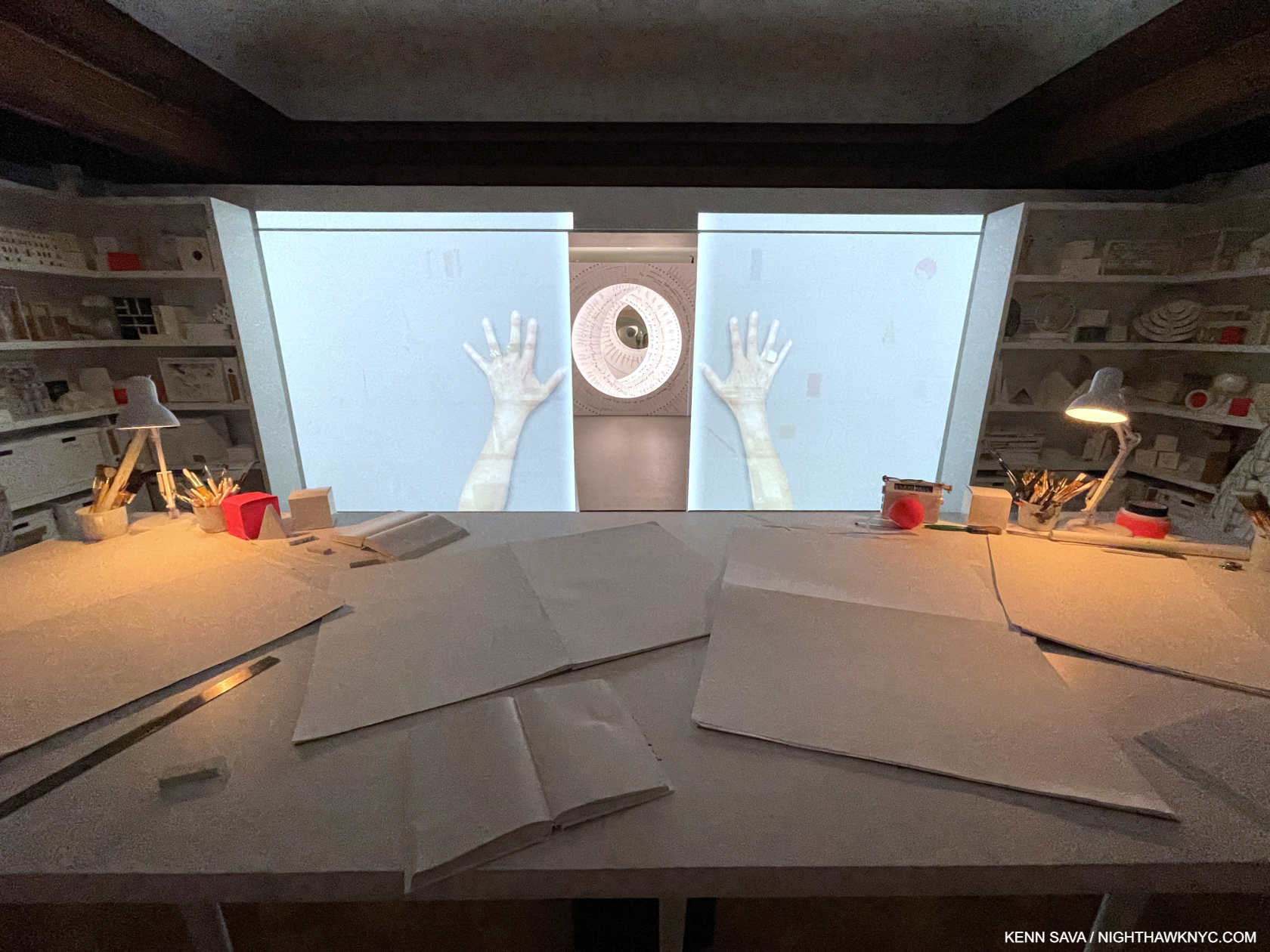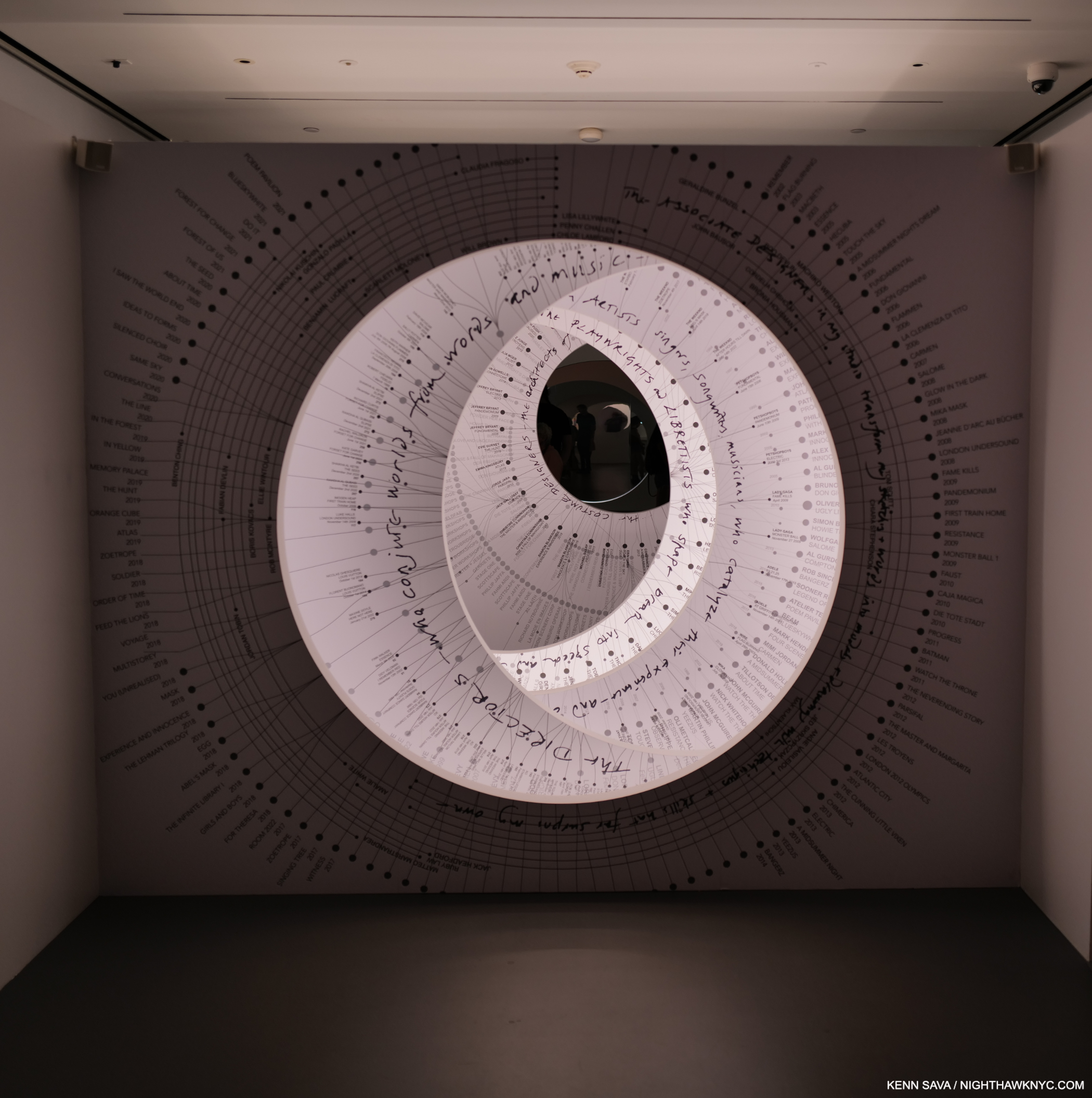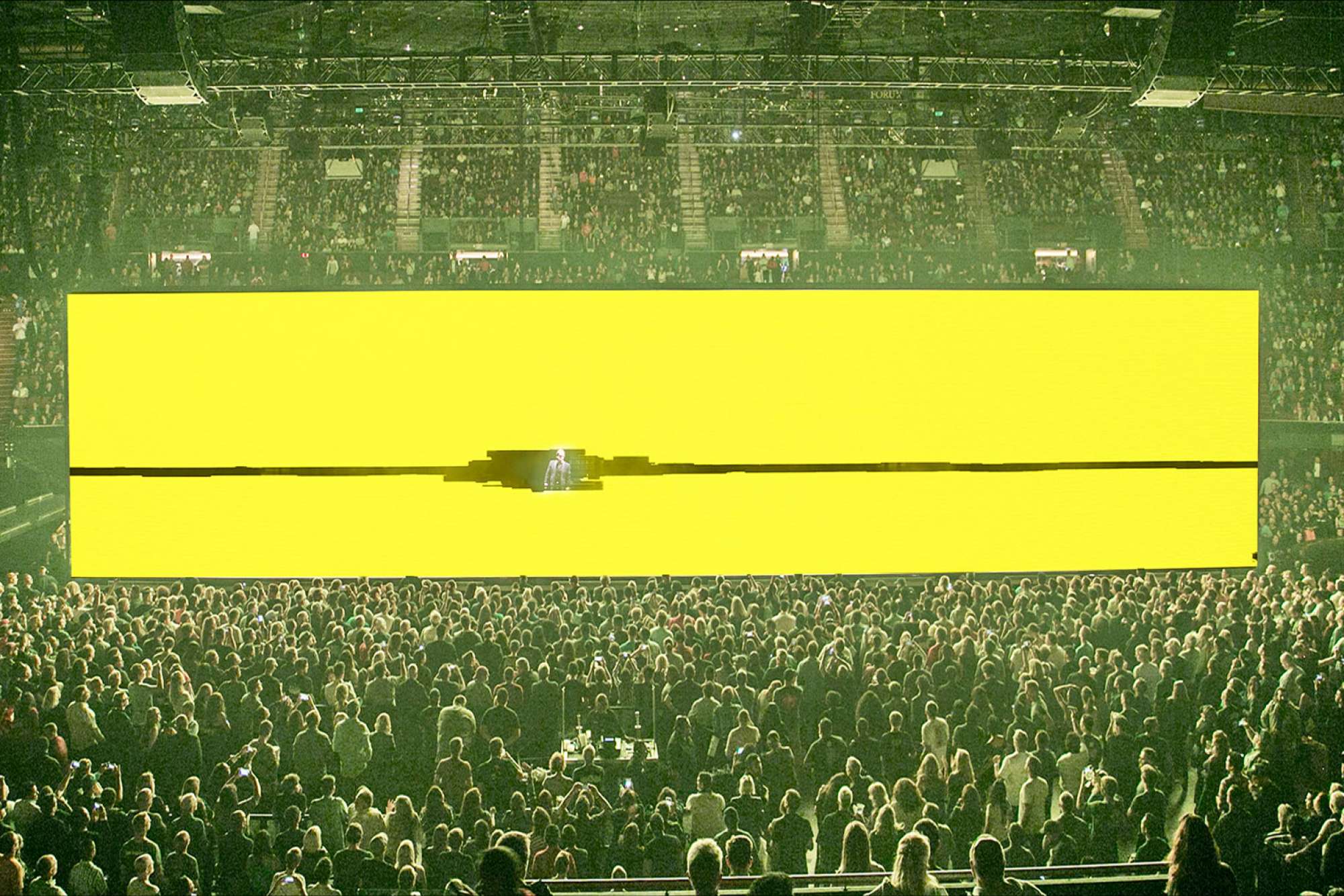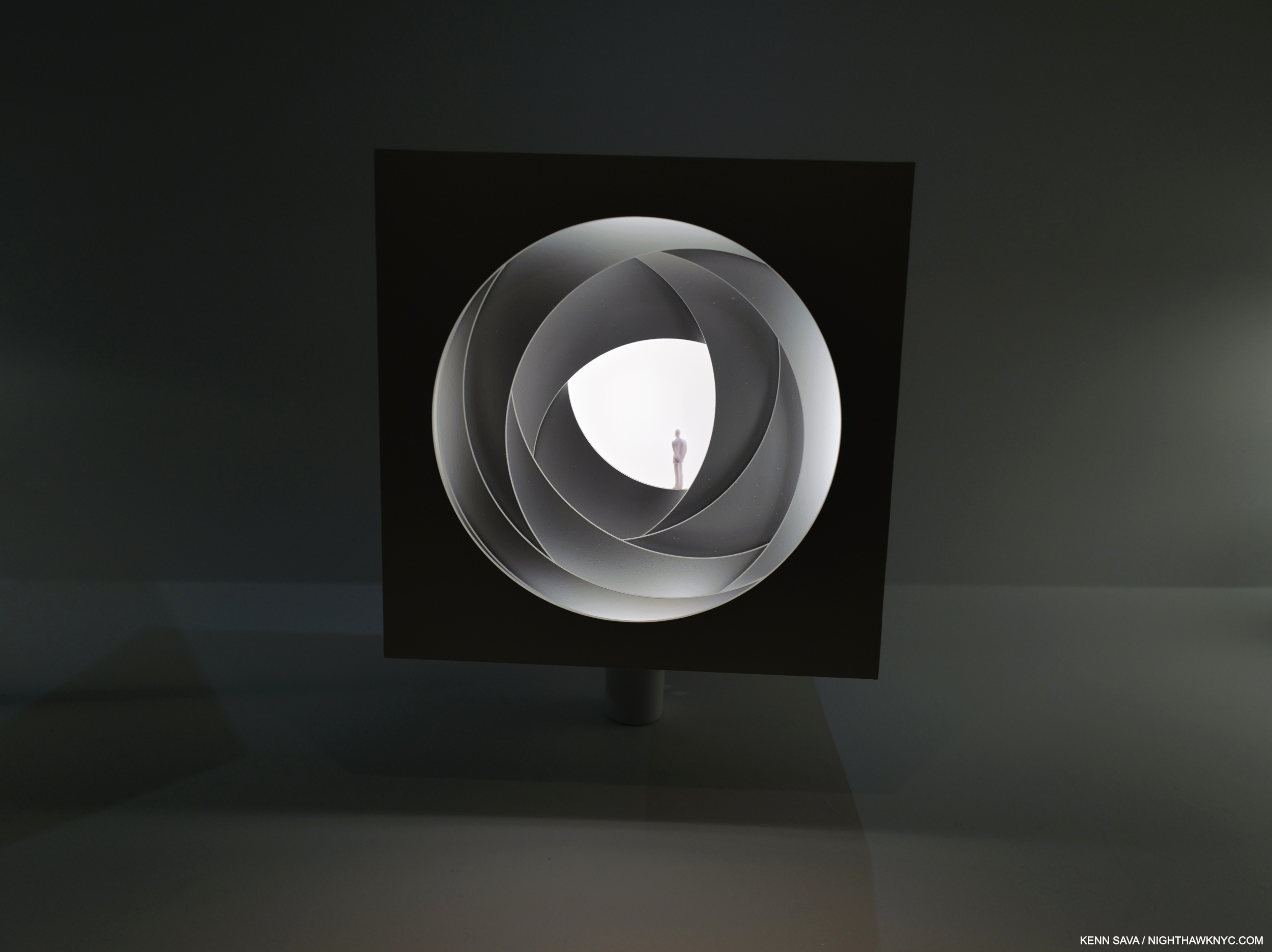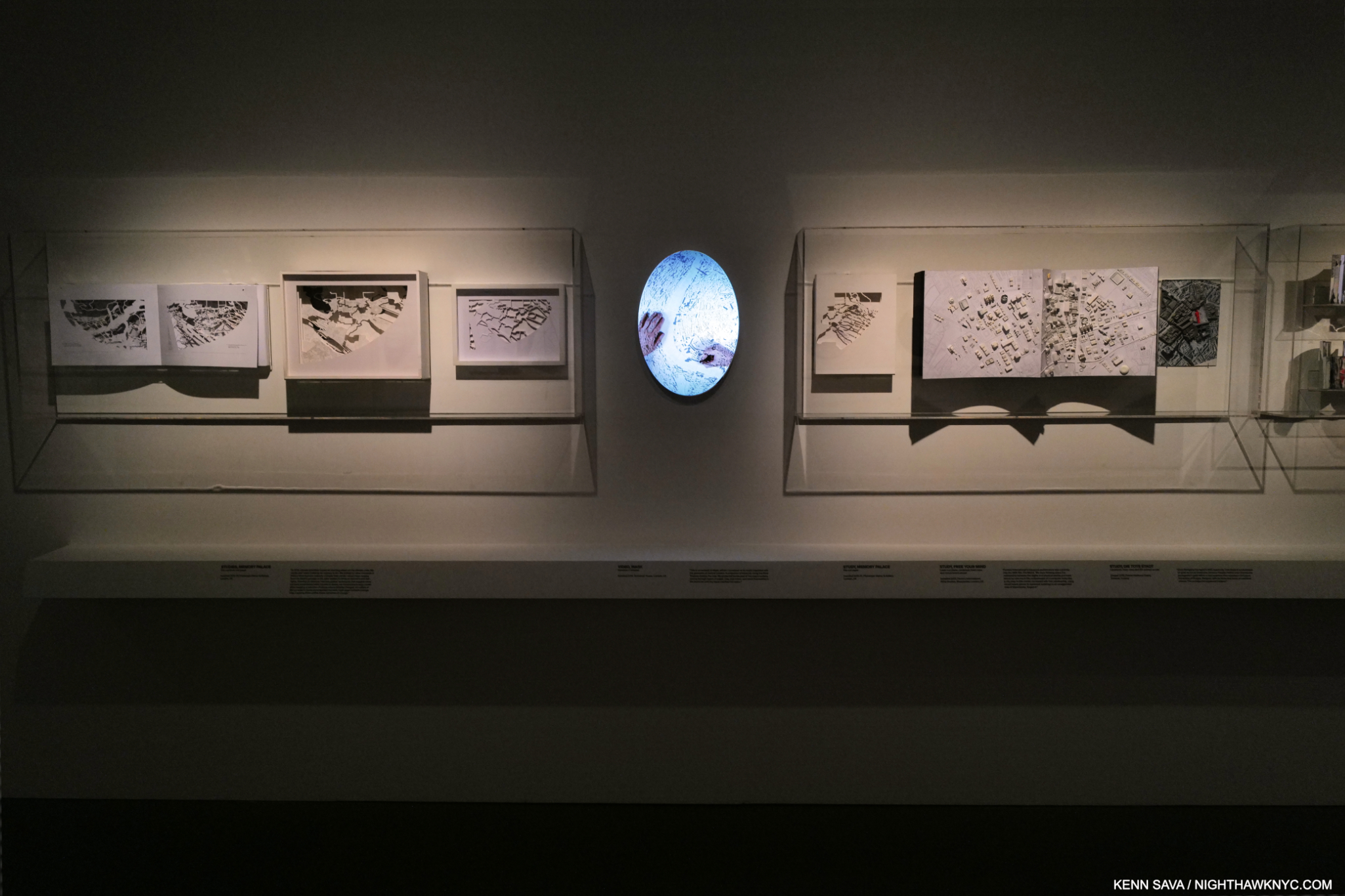This site is Free & Ad-Free! If you find this piece worthwhile, please donate via PayPal to support it & independent Art writing. You can also support it by buying Art & books! Details at the end. Thank you.
Written & Photographed by Kenn Sava (*- unless otherwise credited).
Show Seen: An Atlas of Es Devlin @ the Cooper Hewitt, Smithsonian Museum of Design
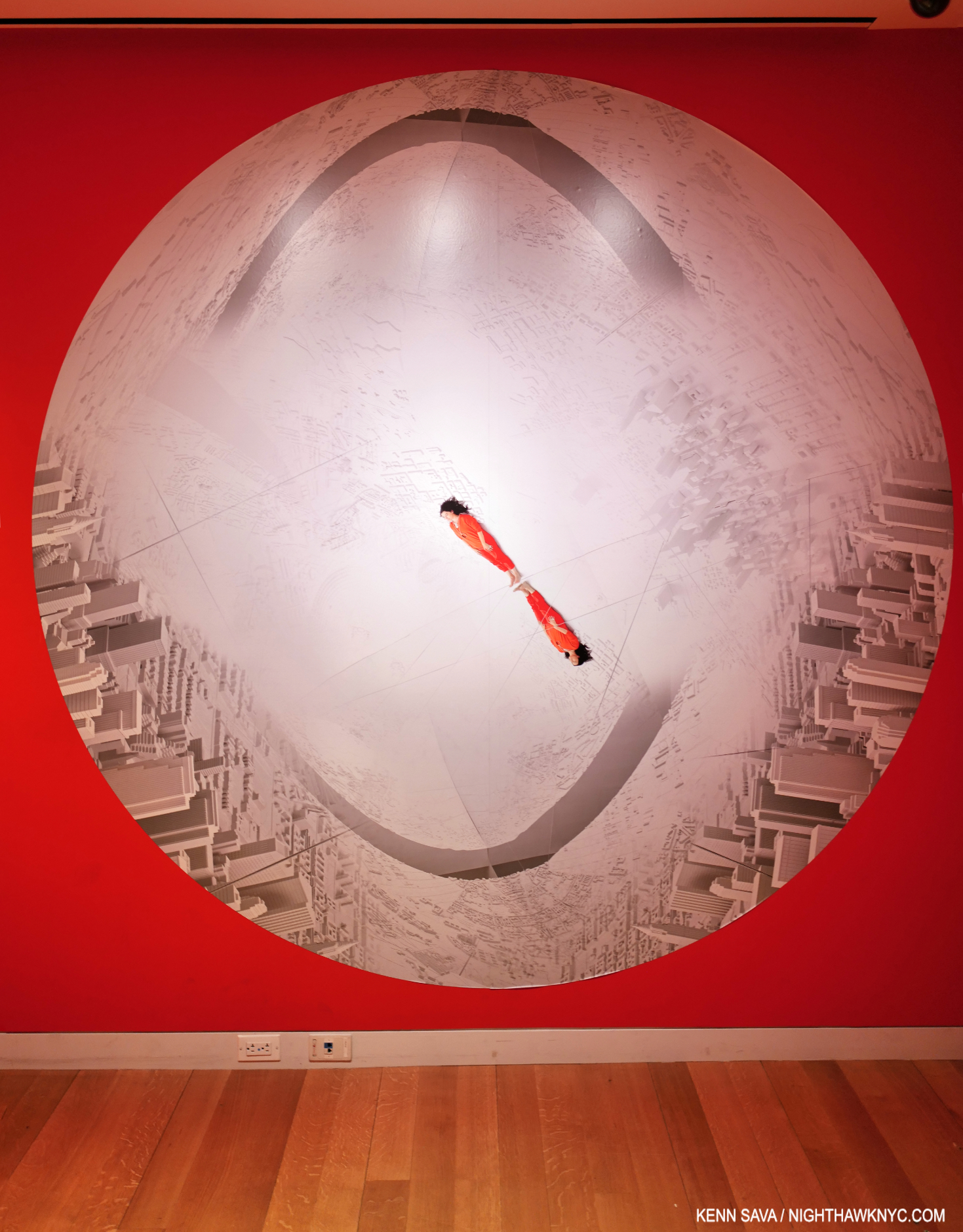
The one and only Es Devlin in the one and only time she appears in her show, in her piece Memory Place. (her hands appear a few times elsewhere). Displayed in the show’s entrance lobby where visitors wait for the next showing of her 4-minute intro video which takes place in a fascinating recreation of her studio. The pictures in this piece are thumbnails. Click any for full size.
Having first experienced Es Devlin’s brilliance in 2010, the release of her debut Art , An Atlas of Es Devlin, the NighthawkNYC.com NoteWorthy Art Book of the Year for 2024, fired my curiosity as to what the show of the same name would be like. How would Es Devlin and the curators at the Cooper Hewitt distill the innumerable projects Ms. Devlin has been involved in these past 29 years already, and the book’s 900 pages, into a comprehensive and concise show, a “mid-career” retrospective, no less?
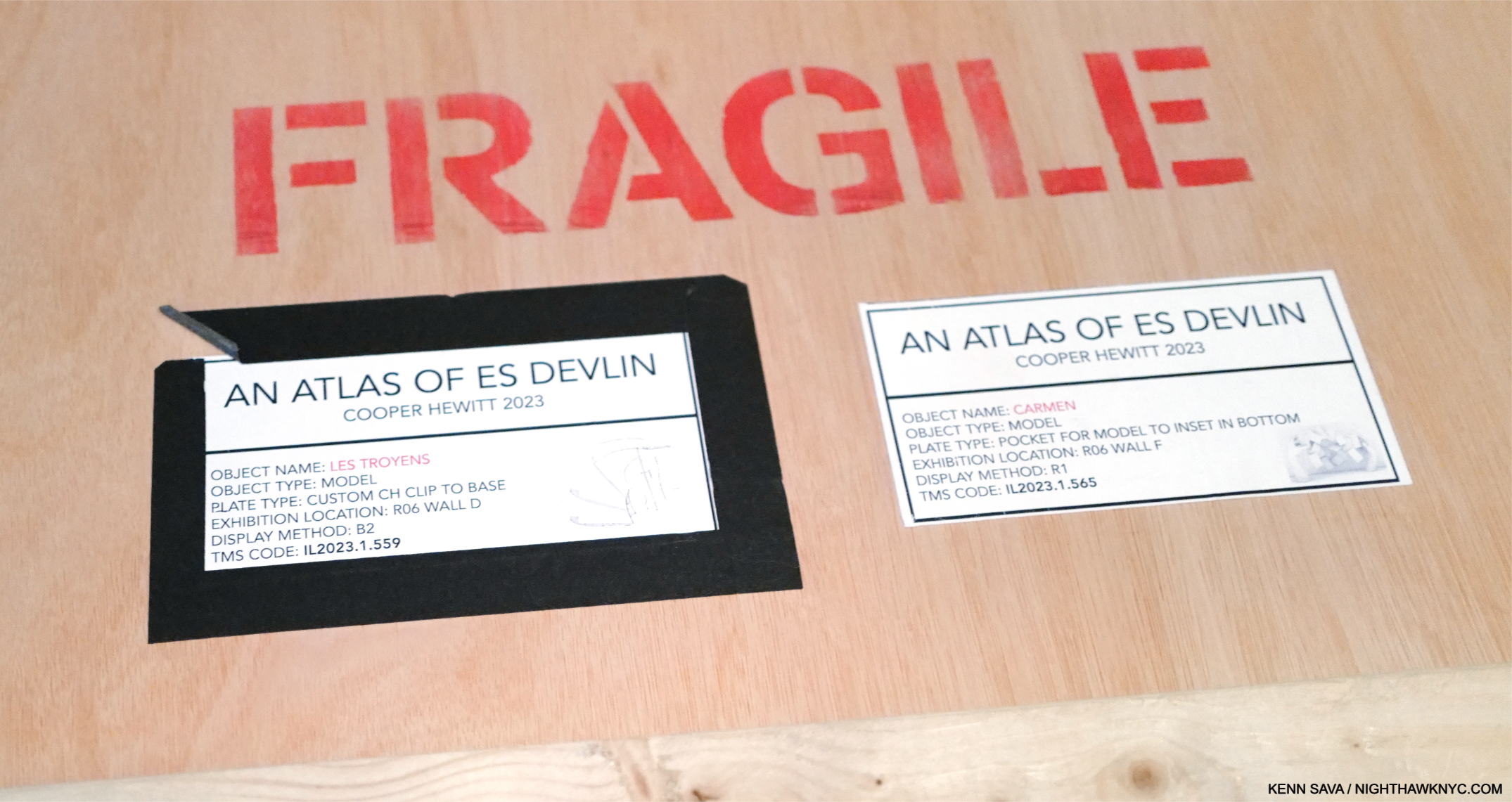
The show is so innovative, the attention to detail so exceptional, that even the shipping crates that transported the Art have their place in it! One of many things in An Atlas I’ve never seen before. I explain further on. Seen here are the labels on a crate that contained 2 models.
Opening in November, 2023, I pondered this all through 2024 as various ailments kept me from getting to 2 East 91st Street, and finding out. Stage Design is one of the most ephemeral Art forms there is. The book is divided between Sketches and notes, followed by a large section of color Photos of the performances. Building my expectations around that, finally getting to see the show twice during it’s final week, I got the unexpected: a show that largely consisted of beautiful scale Models of the stage sets, most created for exhibition! (Two were contained in the shipping crate shown here.) Well, if anything has proven to be the trademark of Es Devlin’s work, it’s the unexpected, which continues to remind me of Robert Rauschenberg.
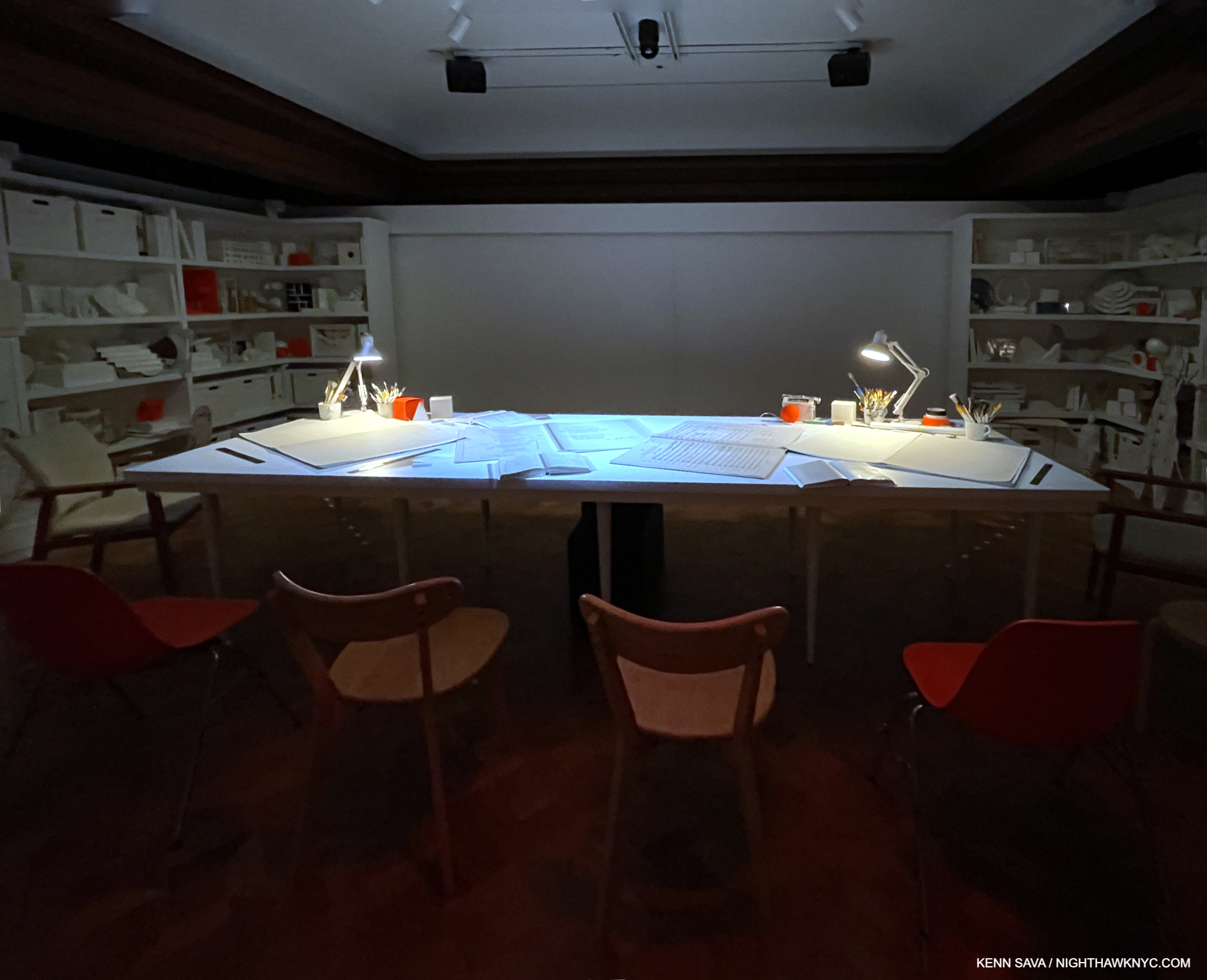
Hang on to your hats! Installation view of the introductory gallery in the recreation of her studio before the Film begins. I rushed in to get this shot before it was filled up by those in line behind me. Beware, those seemingly innocent items on the table are not what they seem. Neither is that back wall.
Filling the entirety of the 3rd floor, arriving visitors are asked to wait for the next showing of a 4-minute Introductory Film, which takes place in a gallery designed as a recreation of her studio, with a large work table in the middle, filled with the tools of her craft.
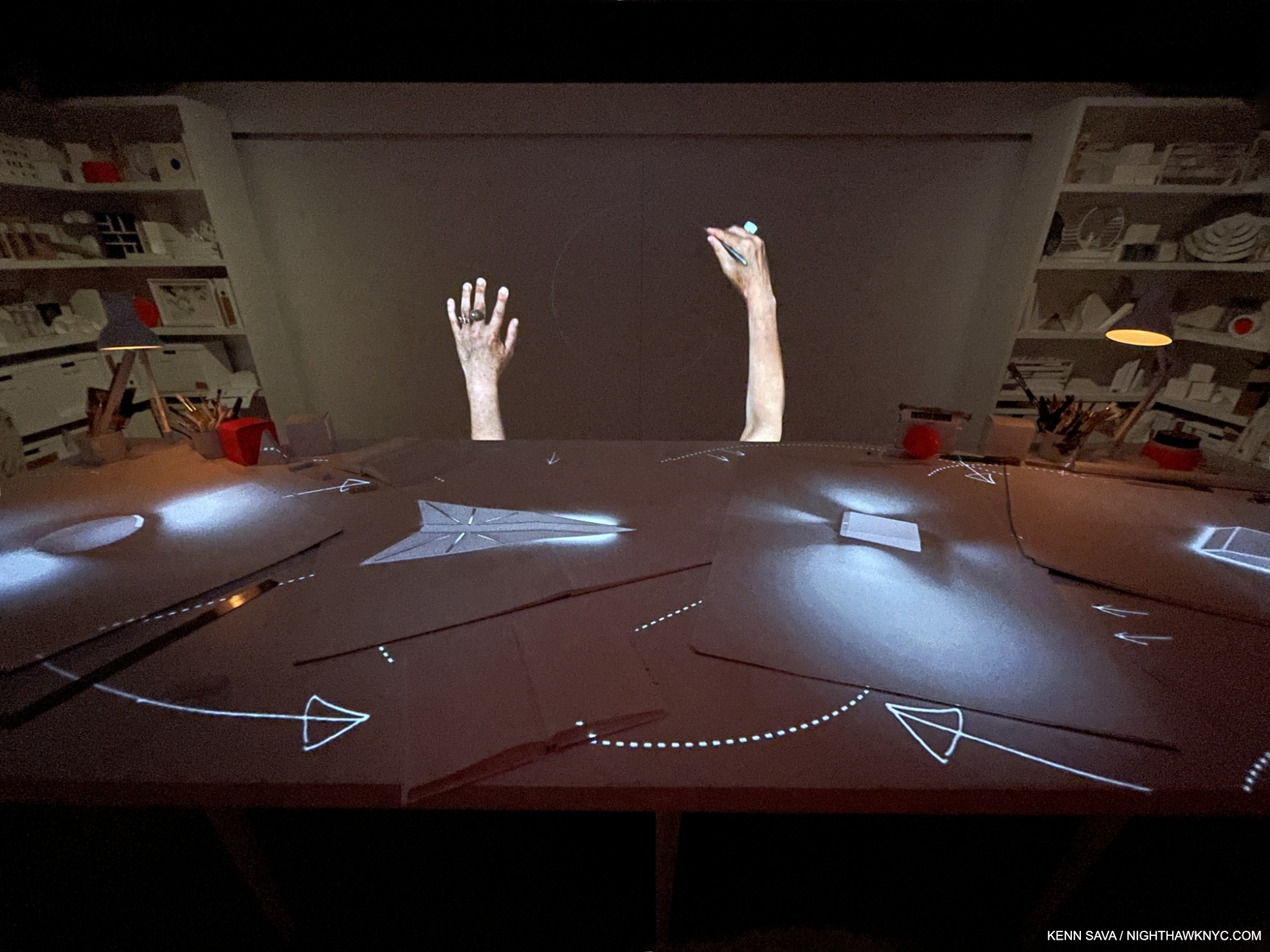
As the Artist speaks and Draws in the Video projected on the rear wall, the objects on the table undergo all sorts of permutations.
As visitors surround it and begin to take it all in, the Film begins. Compellingly narrated by the Artist in powerfully evocative words in Ms. Devlin’s hypnotic voice, accompanied by stunning visuals that somehow bring items lying on the table to life, the Artist takes us on a tour of her ideas and her work.
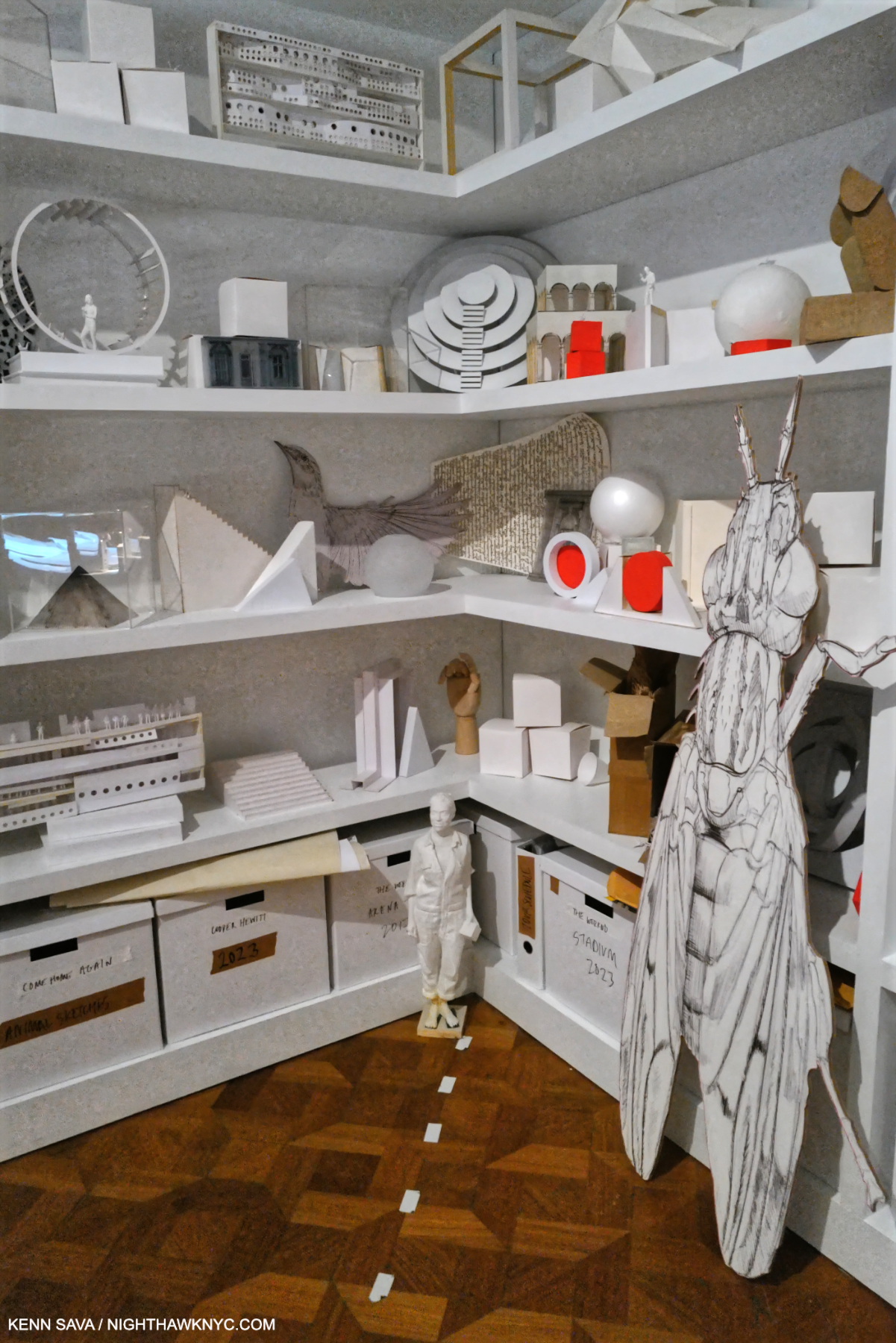
One section of the recreation of Es Devlin’s studio with the lights low during the Introductory Film. Full of ideas, some realized, some partially realized, some not realized yet, I imagined this room to be something akin to walking around in her brain.
On three of the walls surrounding the table were a cornucopia of fascinating objects I could have spent a few hours studying on their own. A bit like Sarah Sze’s incredibly involved installations, a lot of work went into their installation.
At the culmination of the presentation, the Artist’s hands split the screen in half, opening the back wall, revealing her piece, Iris, beckoning visitors to enter the beginning of the main body of the show. Talk about a dramatic opening. Stage craft meets Art show in a way I can’t say I’ve experienced before. But, I bet I will again. I have no doubt An Atlas was must-see viewing for innumerable curators and gallerists.
Working with “names’ virtually her entire career, the first stop is her Iris with a voice over of Es reciting the names of her collaborators. A nice “Thank You” for the opportunities and sharing the credit for the results of this most collaborative of mediums. Iris, with multiple aperture blades, contains the names of the Artist collaborators on the outer blades, and all those involved with creating and mounting her projects fill the inner blades, a list that fills the first 9 pages in her book! It introduces what is a running theme in the show: collaboration, as you might expect for an Artist whose craft is Stage Design, like a bass player, something that doesn’t exist on its own (unless you’re a genius, like my late acquaintance, Jaco Pastorius). Still, it’s definitely her show. Her voice and vision runs through each and every work. Still, as any creative person who’s been hired by someone knows, working with someone else “who has a say” is often extremely challenging; perhaps the hardest part of the job. More than likely the Artist got the job for being who he or she is. For someone else to come in and suddenly want to change/modify that vision can be both counterproductive and counterintuitive. Not every Artist can do it. The “dynamics” of creative collaboration is why most bands have the shelf life of milk. Yet, though it must have been there, in An Atlas there is no sign of creative struggle or difficulty. Making this all the more impressive, the list of her projects takes 4 pages in the book (as I showed here)! Either her brilliance is just a matter of fact for all her bosses, or she has an extremely winning way, as belied by her hypnotic voice. My money’s on both.
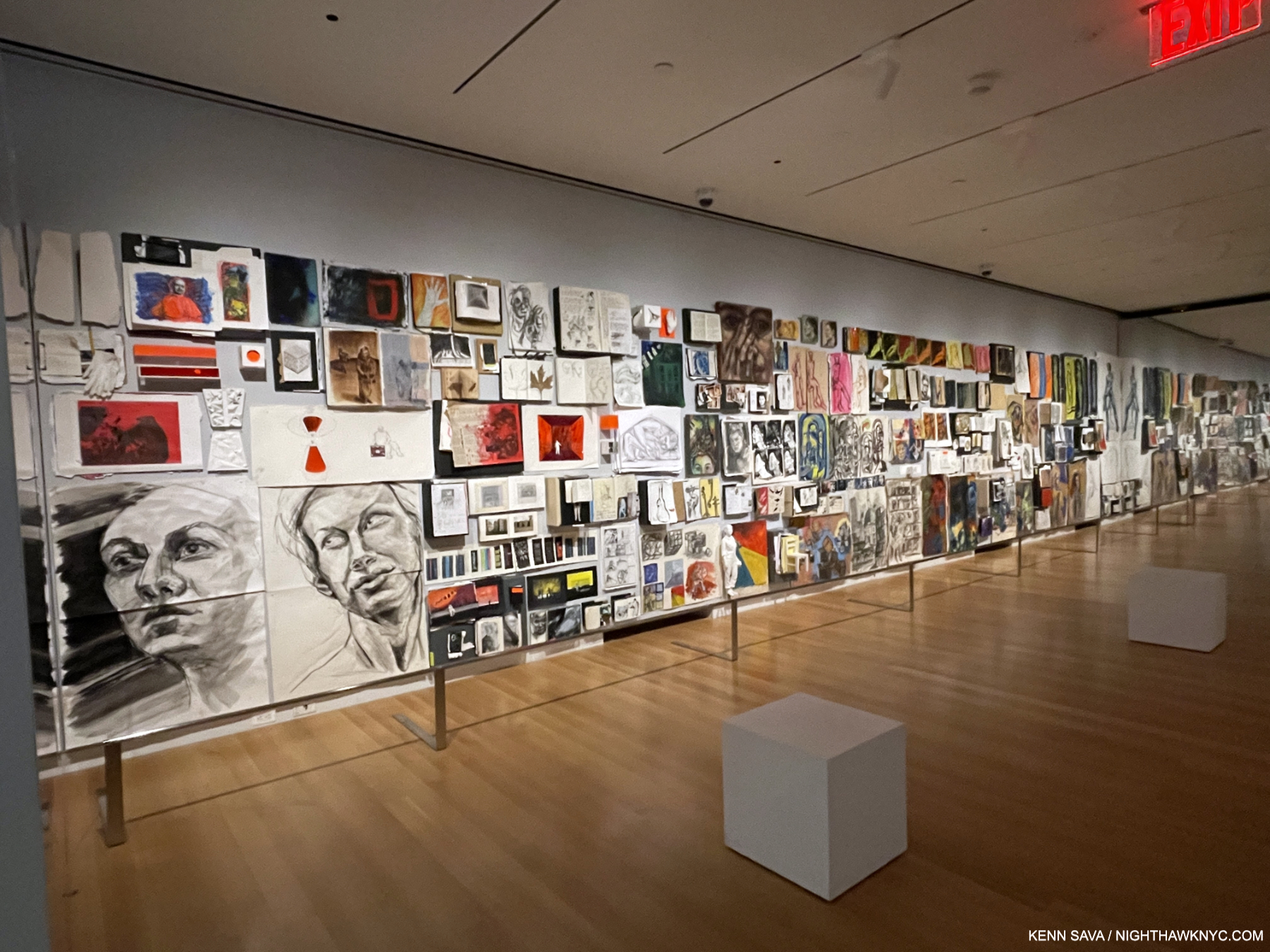
Installation view of the first gallery of work, with the earliest pieces at the far end. If you look closely you’ll notice mirrors at each end of the wall. In what might have been an effort to make the show feel larger, all the galleries had wall-sized mirrors on each end.
After leaving Iris, next up is the gallery of her fascinating early works, largely Drawings and Mixed Media works on paper, i.e. pen, markers, paint on paper Portrait and figure studies, like countless other Art students. I had to look closer to find the roots of her Stage Design work. In between the large studies, I saw sketchbooks, notebooks and loose sheets that contained outlines and ideas for stage productions, none of which are listed in her book.
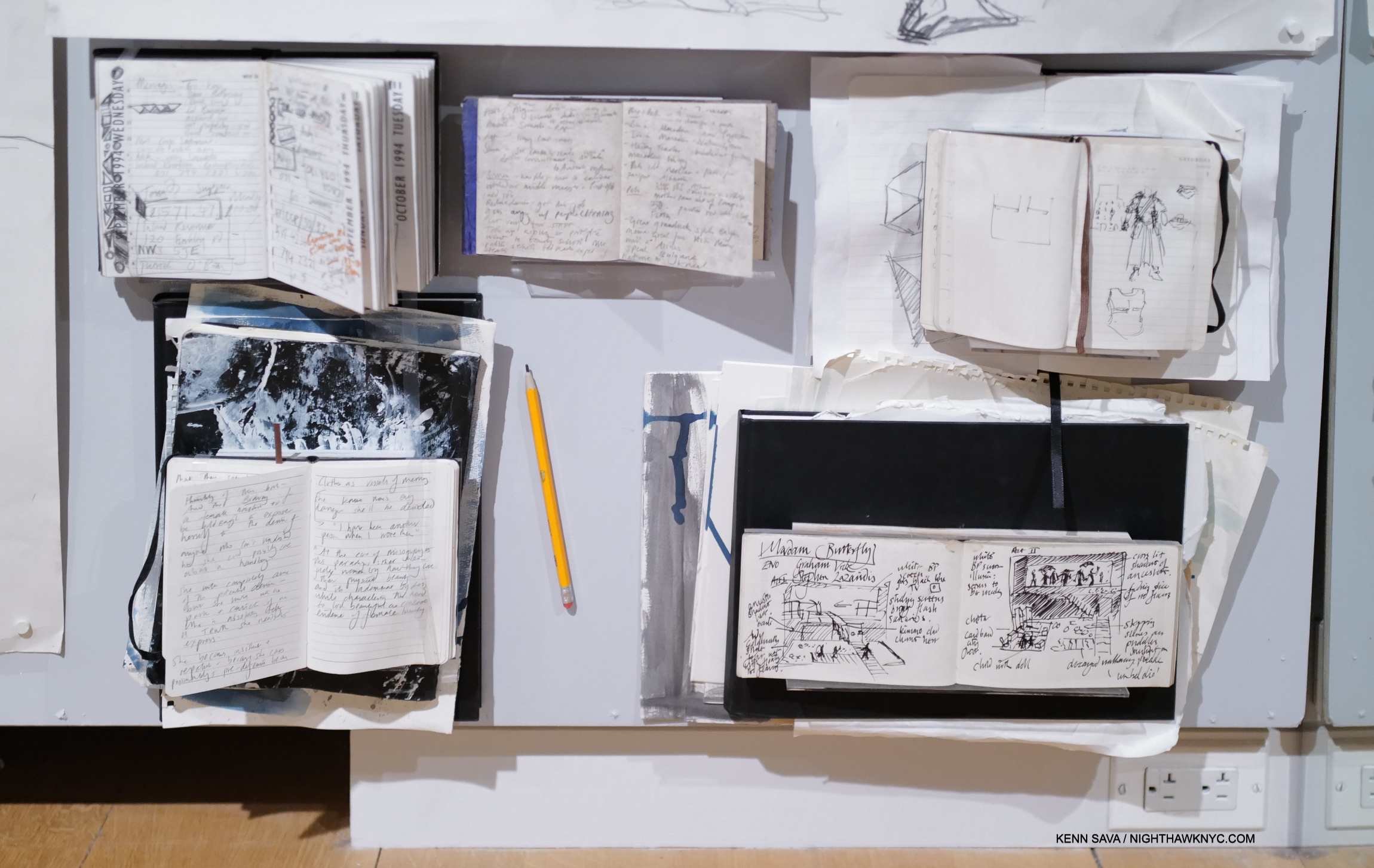
On the very bottom of the far end of the wall, just above the power outlets, and so difficult to see, I spotted these notebook pages, the one at the lower right reads “Madam Butterfly,” perhaps one of the earliest Stage Designs in the show (the book in the upper left is dated October, 1994). Note that Es has Drawn the entire thing, boldly and confidently, in ink with no white-out or corrections. That speaks to the clarity of her vision, even early on. Immediately above it is a costume design. Note the inclusion of the pencil. I just love that her work was so centered on Drawing and hand-written notes, and continues to be. I don’t see Madam Butterfly listed in her book.
From this gallery, what are we to make of her beginnings? Where did all of what has followed come from? Between visits, I researched her background. Her CV on esdevlin.com, lists her Education, chronologically, as-
-Cranbrook School, 1984-1989 (a “co-ed grammar school1)
-BA Hans English Literature 2.1, Bristol University, 1990-1993
-Fine Art Foundation, Central Saint Martins, UAL, 1994-1995
-Motley Stage Design Course, 1995-1996
That’s it! After taking Art-centric courses for scarcely two years, then she just takes off. In only the second gallery of work, at the beginning of her professional career, the ideas are fresh, innovative & previously unseen- qualities that characterize her work to this day. Still in school(!), she’s already on her way. In the first vitrine, I was struck by her work with Wire, a 4-piece rock band, in 2003. Zillions of 4-piece bands, including a few with yours truly involved, have appeared on stage since The Beatles set a standard for what such a lineup “should” look like. “I didn’t know much, but I was bored of seeing the typical silhouette of a band,” she said on the wall card (where all Es Devlin quotes herein derive).
And so, Wire appeared like this-

Studies: Flag: Burning, for the band Wire’s Farewell Performance, 2003, Barbican Hall, London. Es Devlin’s first stage design for a concert. She made “illustrated cue sheets from which they ran the lights and the videos.” She spoke about not having enough money to afford velcro to enclose the band, so she had to use staples.
11 years later, another 4-piece band looked like this-
Wire would lead to such extraordinarily innovative shows as “Innocence & Experience,” 2014, and the subsequent “Experience & Innocence,” 2018, both by U2, who also includes 4 members. I believe this performance of “Who’s Gonna Ride Your Wild Horses” is from the “Experience & Innocence” tour. I saw U2 on what I believe was their first U.S. tour at the Ritz in 1980. Bono still sounds as strong as ever. To my mind, Wire, 2003, to U2 a decade later provides a classic case study in Es Devlin’s evolution.

Model, Bangerz, 3-D printed resin, recreated for exhibition. Staged, 2014, Miley Cyrus’s Bangerz World Arena Tour. Models of Ms. Devlin’s designs were the highlight of the show for me. Here, her face is a video projection from above that continually changed. To the side, a huge model of her beloved dog was also on stage. “We decided the Miley Cyrus should perform the entire show on her tongue. The first iteration was impractical, so we reduced the length of the tongue to a slide, down which Miley made her entrance- a sculptural portrait of a young woman rewriting her own script.”
Moving through the show, it became apparent to me that though elements recur, as. you see, Es Devlin has no one “style.” Since her words appear on virtually every wall card. Who else to speak better about her work? I’ll largely let her take it from here.
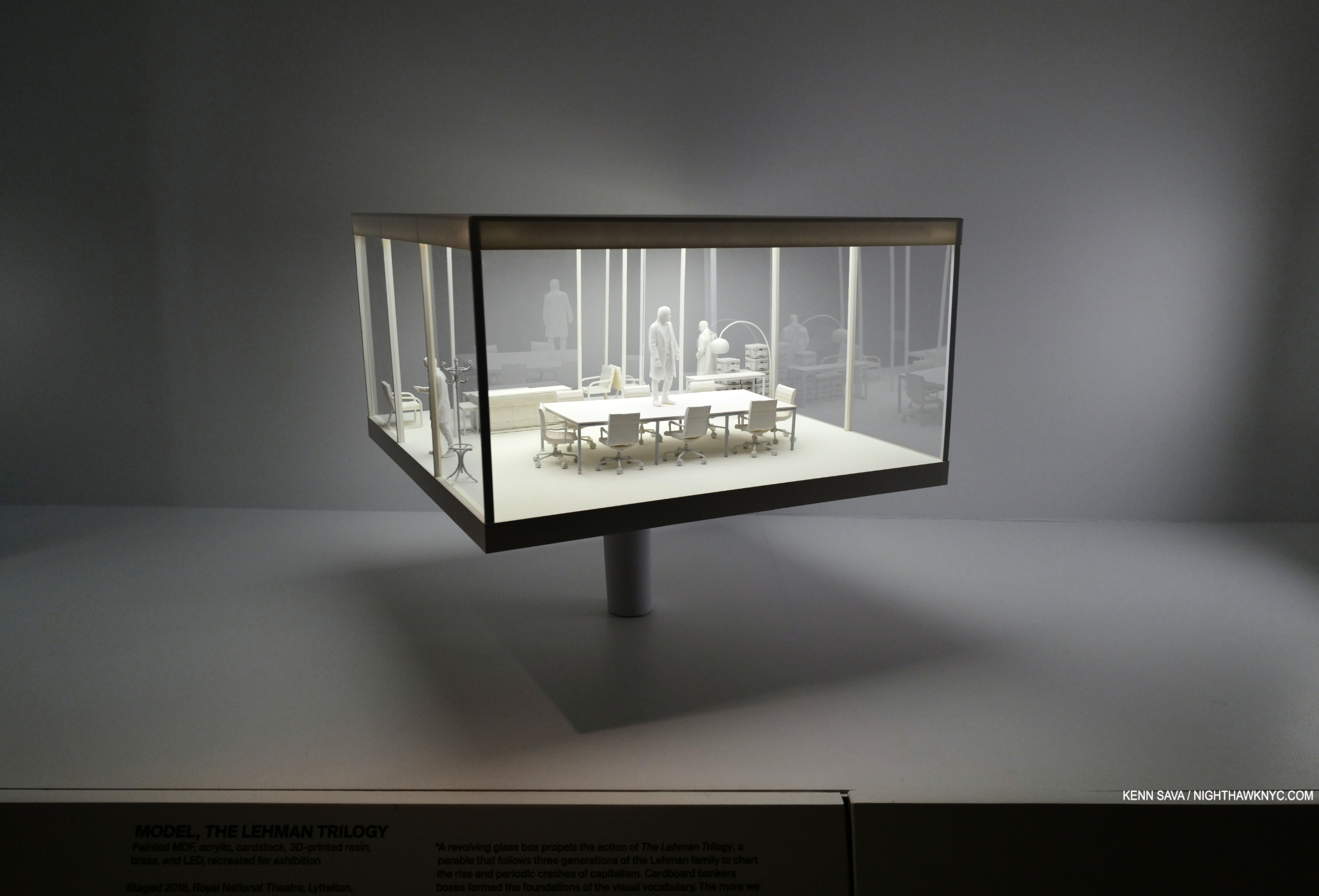
Model, The Lehman Trilogy, Painted MDF, acrylic, yardstick, 3-D printed resin, brass, and LED, recreated for exhibition, Staged in 2018 at the Royal National Theater, London, and the Park Avenue Armory, NYC. Es Devlin’s Tony Award-winning, rotating, design for Stefano Massini’s play The Lehman Trilogy, based on the family of businessmen. All the Models shown here with a center pole rotated. “A revolving glass box propels the action of The Lehman Trilogy, a parable that follows three generations of the Lehman family to chart the rise and periodic crashes of capitalism. Cardboard bankers boxes formed the foundations of the visual vocabulary. The more we invested the boxes with meaning, the more poignant the revelation became that those containers of cotton and coffee would become containers of financial records and numbers, ultimately revealing themselves to contain nothing at all.”
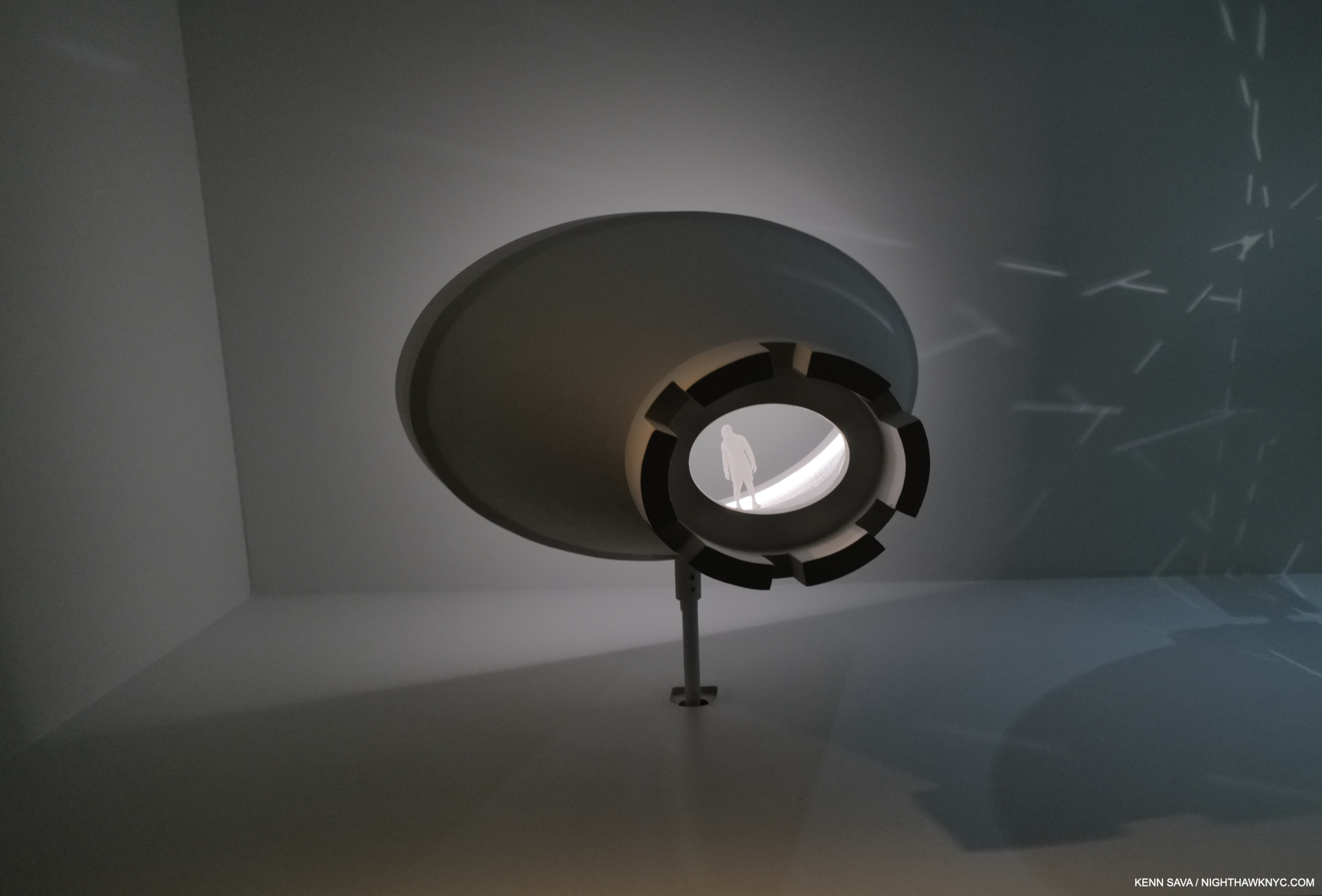
Model, Parsifal, Laser-cut form, resin and paint, recreated for exhibition. Staged in 2012 at the Royal Danish Opera, Copenhagen. “Richard Wagner conceived his final work as a ritual mass for the consecration of a stage. Over four hours of largely static drama, the audience transcends time and space through a rite of compassion. The director Keith Warner and I conceived an enormous revolving rook chess piece whose conical interior formed a new theater within Copenhagen’s opera house. We presented Parsifal’s odyssey from naivety to wisdom as a resistance to the rules of an antiquated game.”
As her career has progressed, a good number of her works have an “otherworldly” feel to them. Figures are frequently enclosed, in a maze, or presented in surroundings that are hard to fathom, often with no apparent way out.
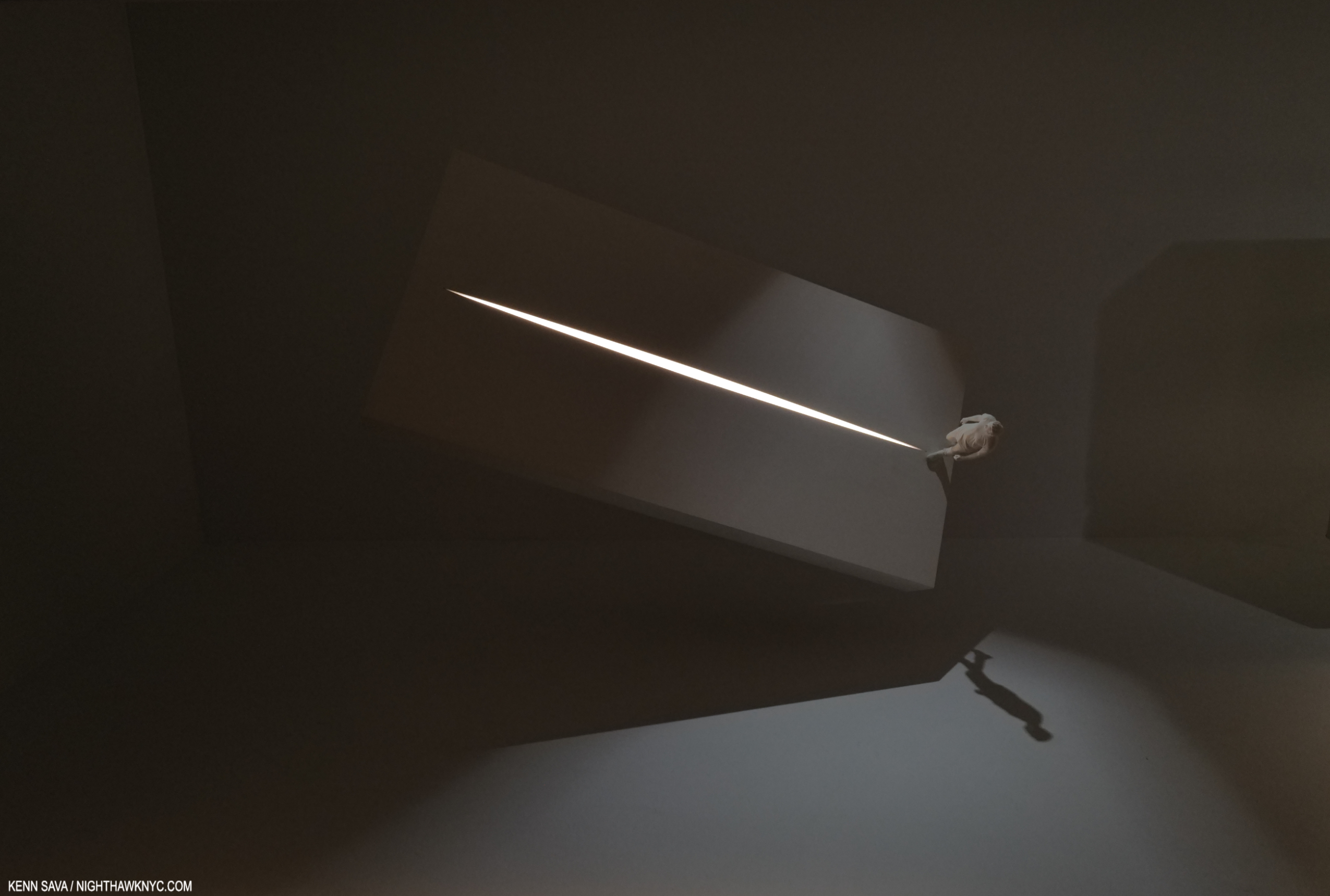
Model, Howie The Rookie, Graphite and paint on laser-cut MDF and LED, recreated for exhibition, Staged 1999, Bush Theater, London, UK. “My first stab designs were experiments in framing light. The Bush Theatre was a room above a West London pub with an audience of 75 people. Mark O’Rowe’s play Howie the Rookie is a pair of potent, visceral monologues set in the housing estates of Tallaght on the outskirts of Dublin, Ireland. I perforated a concrete plane with a line of light. This line conveyed both a burning horizon and a road making on a highway.”
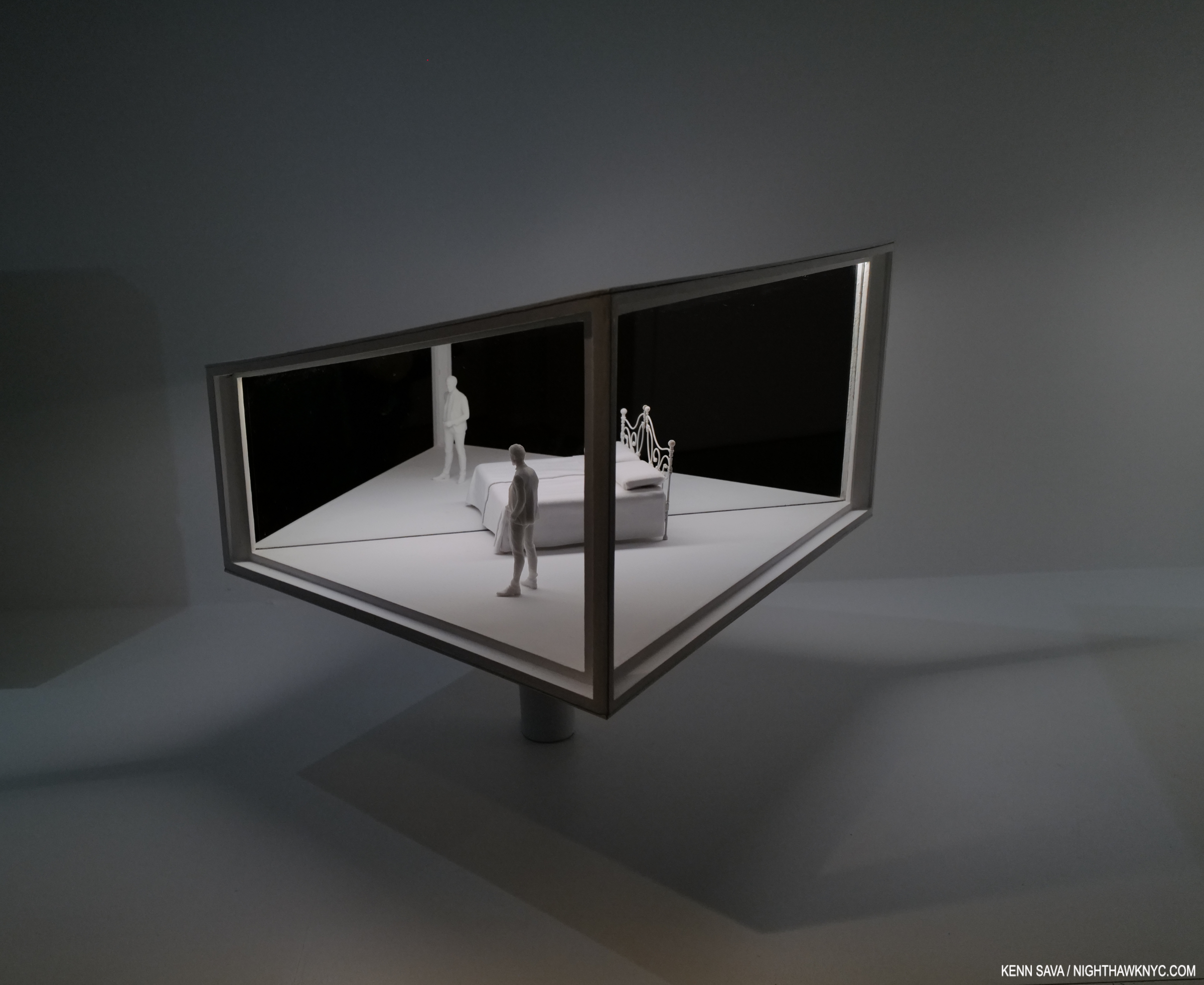
Model, Macbeth, Graphite and paint on laser-cut MDF, acrylic mirror and LED, recreated for exhibition, Staged 2003, Theater an her Wien, Vienna. “The design for Ernest Block’s opera of Shakespeare’s play Macbeth was based on a revolving mirrored illusion box. It’s rotations evoked Macbeth’s churning conscience. We conjured scenes through smoke and mirrors. A half-bed wedged against a mirror appeared as a single whole, while Macbeth and his wife were duplicated. The illusion of a whole banquet full of guests overlaid their machinations as the box turned.”
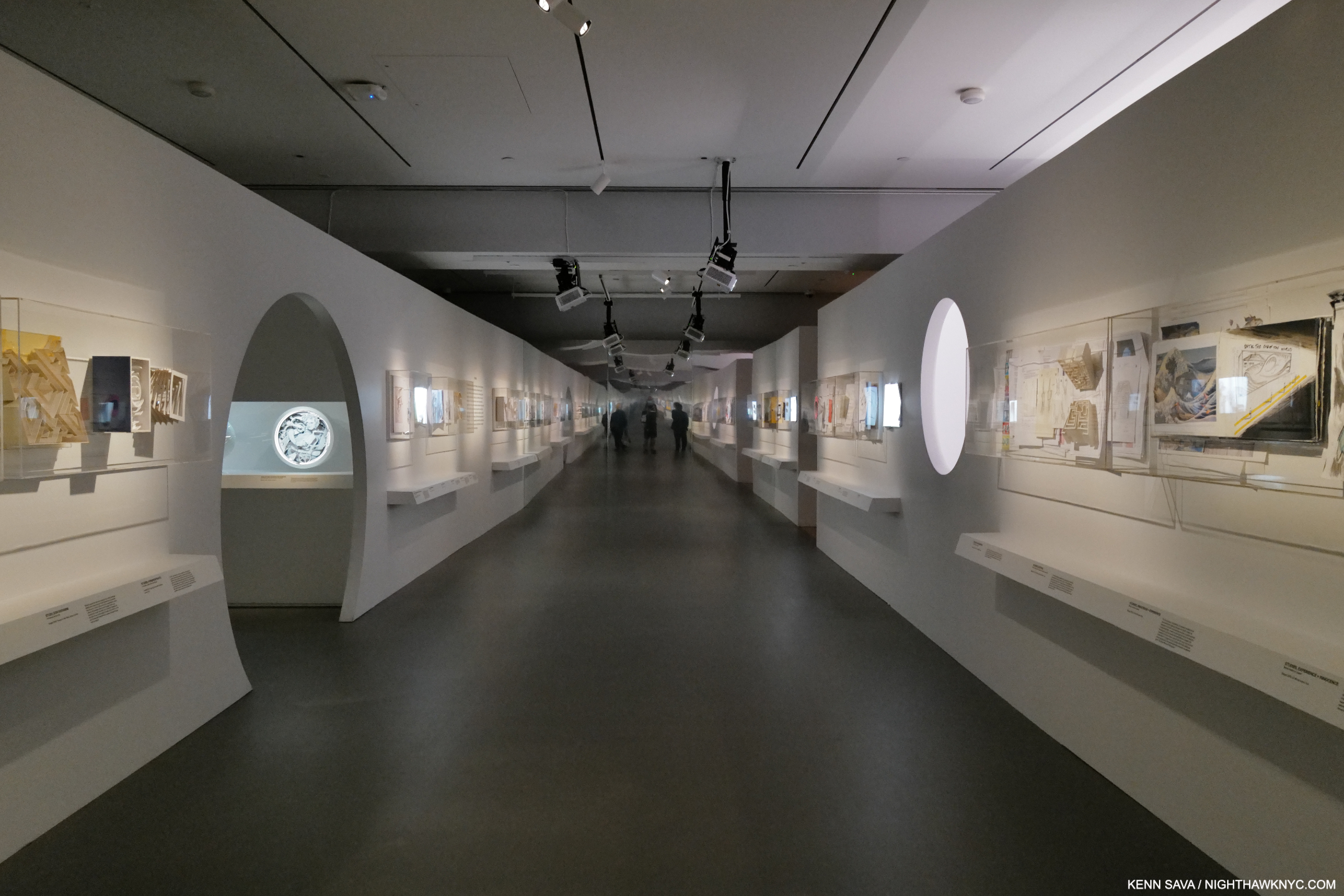
Installation view of one of the corridors. It’s not as long as it looks. Note the overhead video projectors.
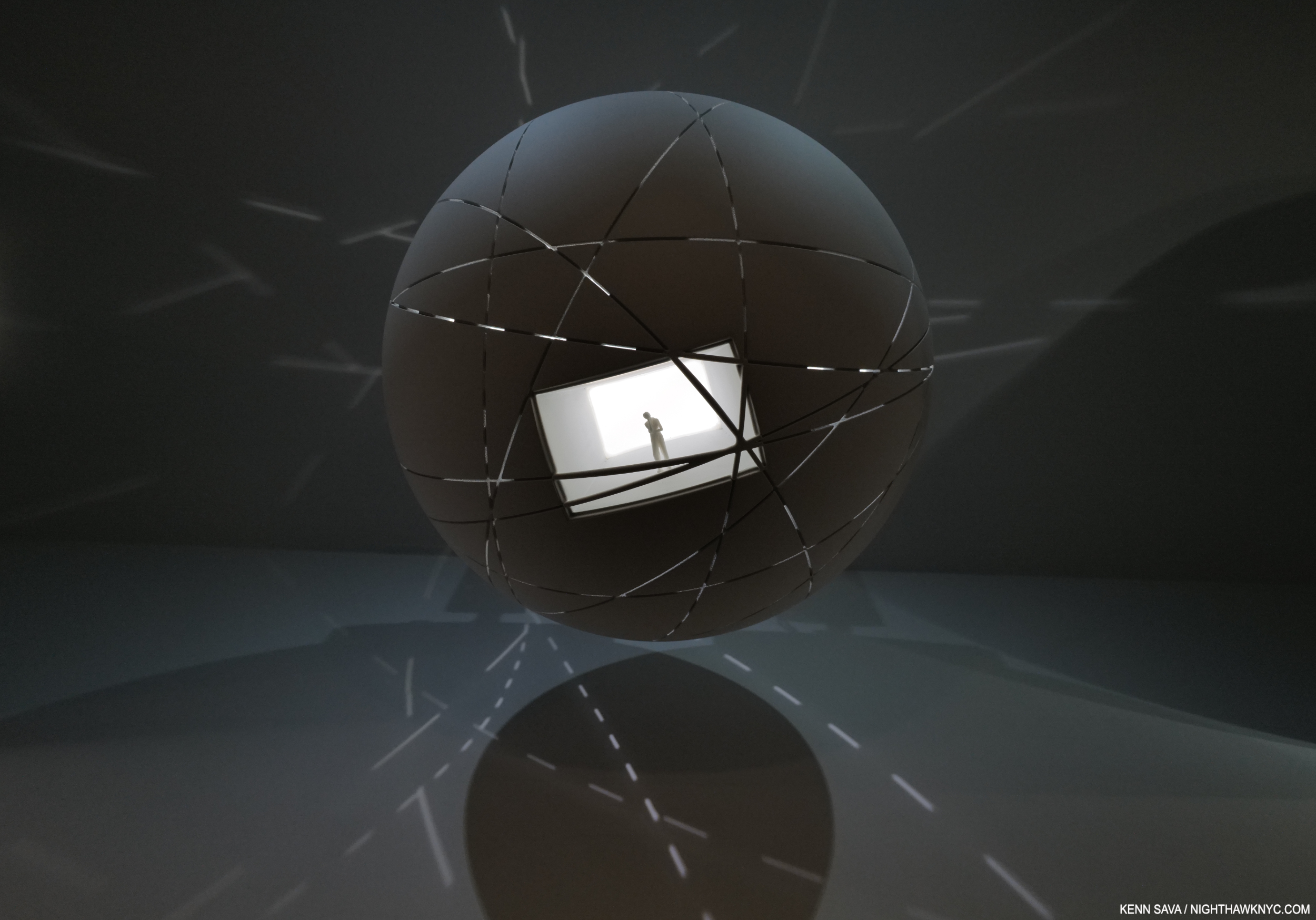
Model, Atlas, 3D-printed resin and LED, recreated for exhibition. Staged 2019, Los Angeles Philharmonic, Walt Disney Concert Hall, Los Angeles, CA. Meredith Monk’s transcendent wordless opera, Atlas, charts the spiritual growth of the 19th-century explorer Alexandra David-Néel. The young girl encounters travel companions and spirit guides within a 12-meter-diameter sphere, scored with webs of international trade and travel routes. The form encompasses Monk’s radiant vision of a possible alternative to the current world order.”
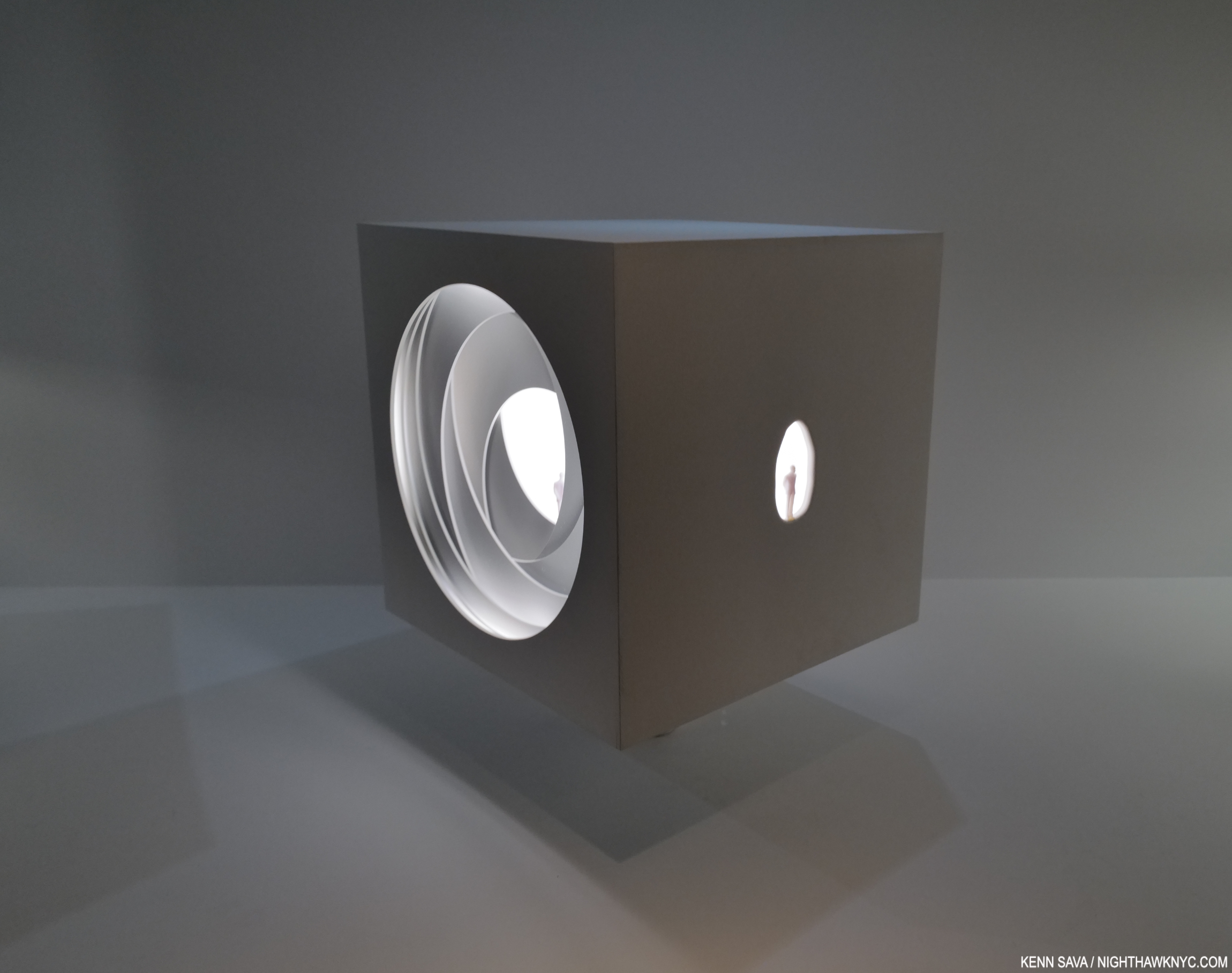
Model, La Caja Mágica/The Seed, Graphite and paint on laser-cut MDF, nd LED, recreated for exhibition. Staged 2010 MTV Europe Music Awards, La Caja Mágica Arena, Madrid, and 2020, Jubail Mangrove Park, Abu Dhabi. “For the MTV Europe Music Awards, I imagined a 10-meter high revolving box that could reveal a shapeshifting series of performances. (Among others) Rhianna sang within a sea of red carnations pouring out of an iris (see next pic).”
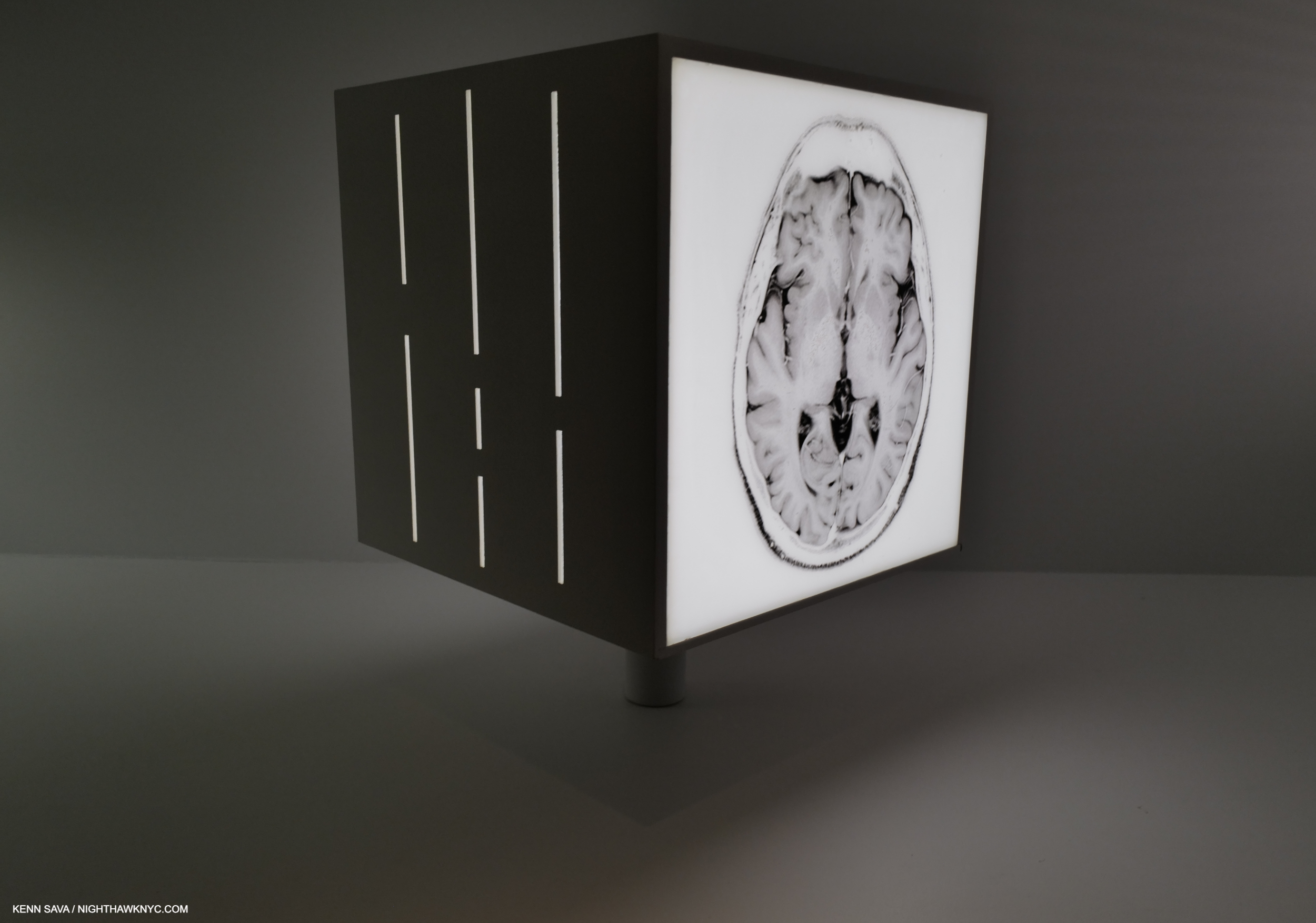
Model, Fundamental, MDF, acrylic, acetate, and LED, recreated for exhibition. Staged for the Pet Sop Boys World Tour, 2006-7. Es says, “Neil Tennant and Chris Lowe’s album Fundamental critiqued Tony Blair, George W. Bush, the Iraq War, and immigration policy. For the tour, an X-ray image of a divided brain expressed the cognitive dissonance we felt as our country remained entangled in a ware we didn’t want. The show was performed outside the Tower of London, complete with projected pink tanks for the anti-war extravaganza ‘The Sodom and Gomorrah Show’ and giant sequined cowboy hats for the Bush/Blair pantomime “I’m with Stupid.”
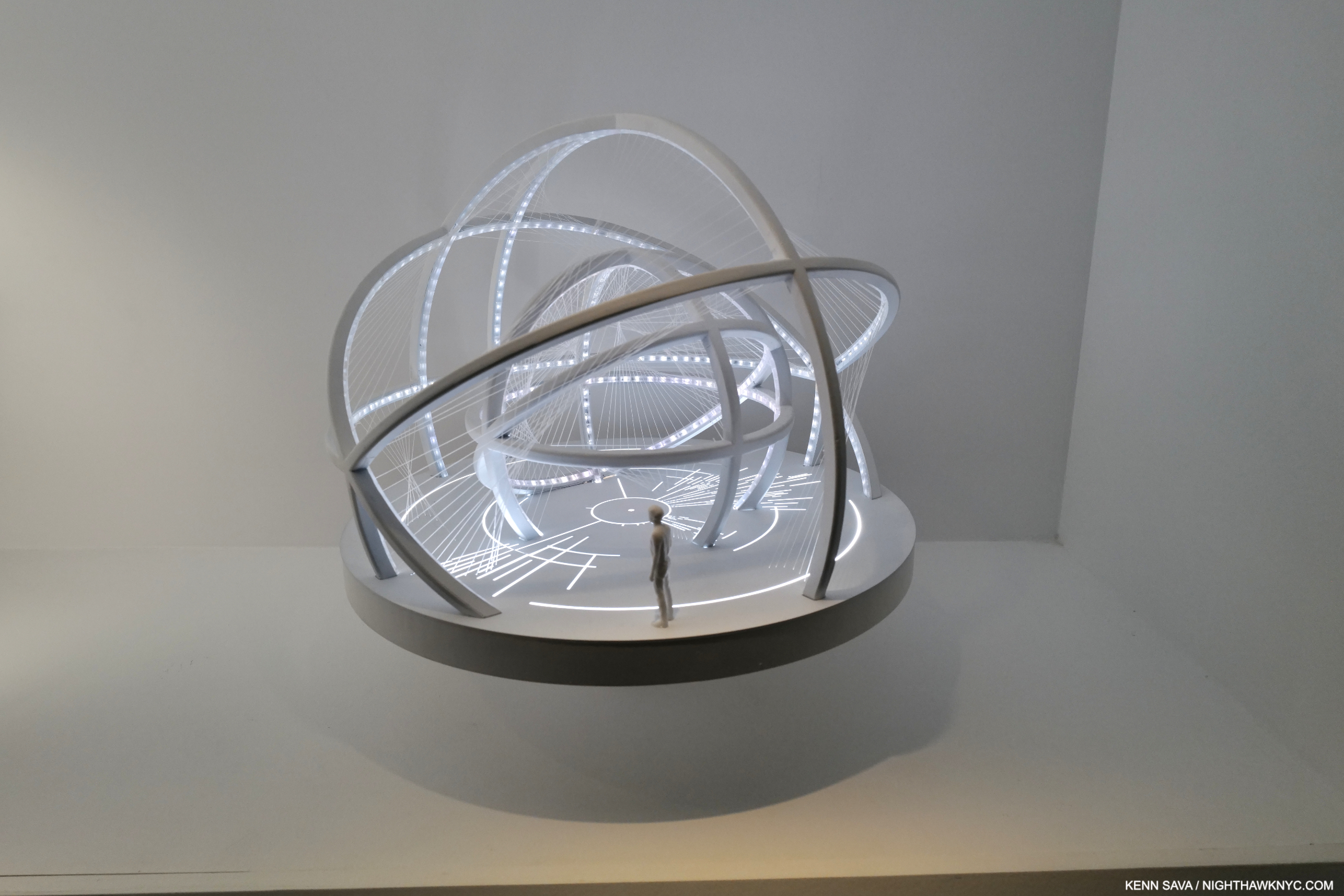
Model, Your Voices, Acrylic, filament, nylon thread, and LED, recreated for exhibition. Installed in the fountain at Lincoln Center, NYC, in 2022, Es says of it, “New York is the most linguistically diverse city on the planet, with 637 languages spoken by its inhabitants. Your Voices celebrated this diversity. Like a giant harp, the sculpture’s glowing arcs enveloped visitors and local choirs with an illuminated web. The piece rotated through a soundscape of languages from all over the city: from Arabic to Ashanti to Zapotec and Zulu. The strands spliced and framed the viewer’s perspectives, just as our perspectives are shifted when we learn to speak through the voices of others.”
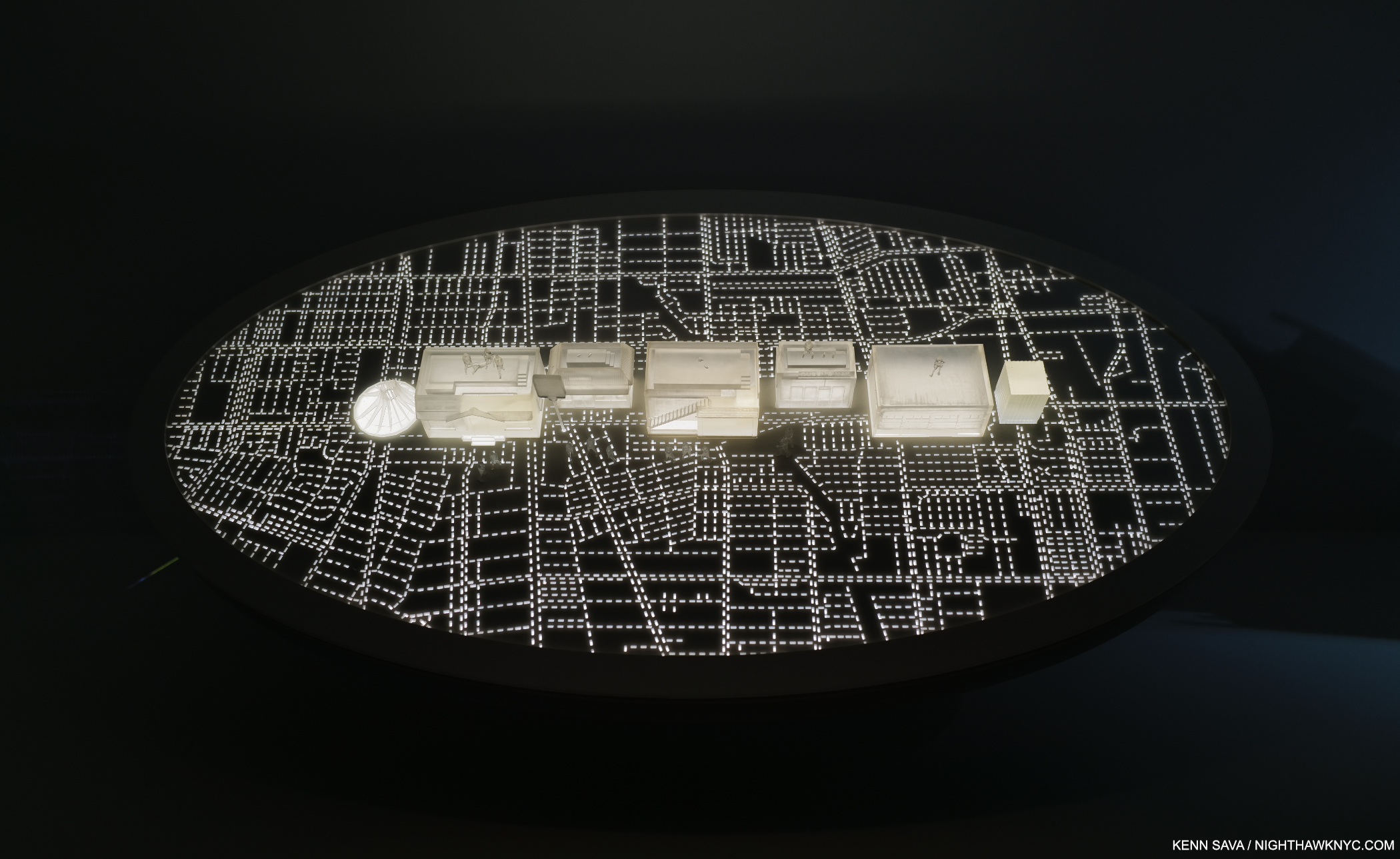
Model, Compton Super Bowl, Laser-cut MDF, acrylic, 3D-printed resin, and LED, recreated for exhibition. Staged for the 2022 NFL Super Bowl Halftime Show featuring Dr. Dre, Kenrick Lamar, Eminem, Mary J. Blige, Snoop Dogg, and 50 Cent, Los Angeles, CA. “Dr. Dre and I proposed etching a map of the city of Compton onto the global Super Bowl stage. We case the buildings as charcters that led from Snoop Dogg’s house to 50 Cent in the club to Eminem breaking out of jail.”
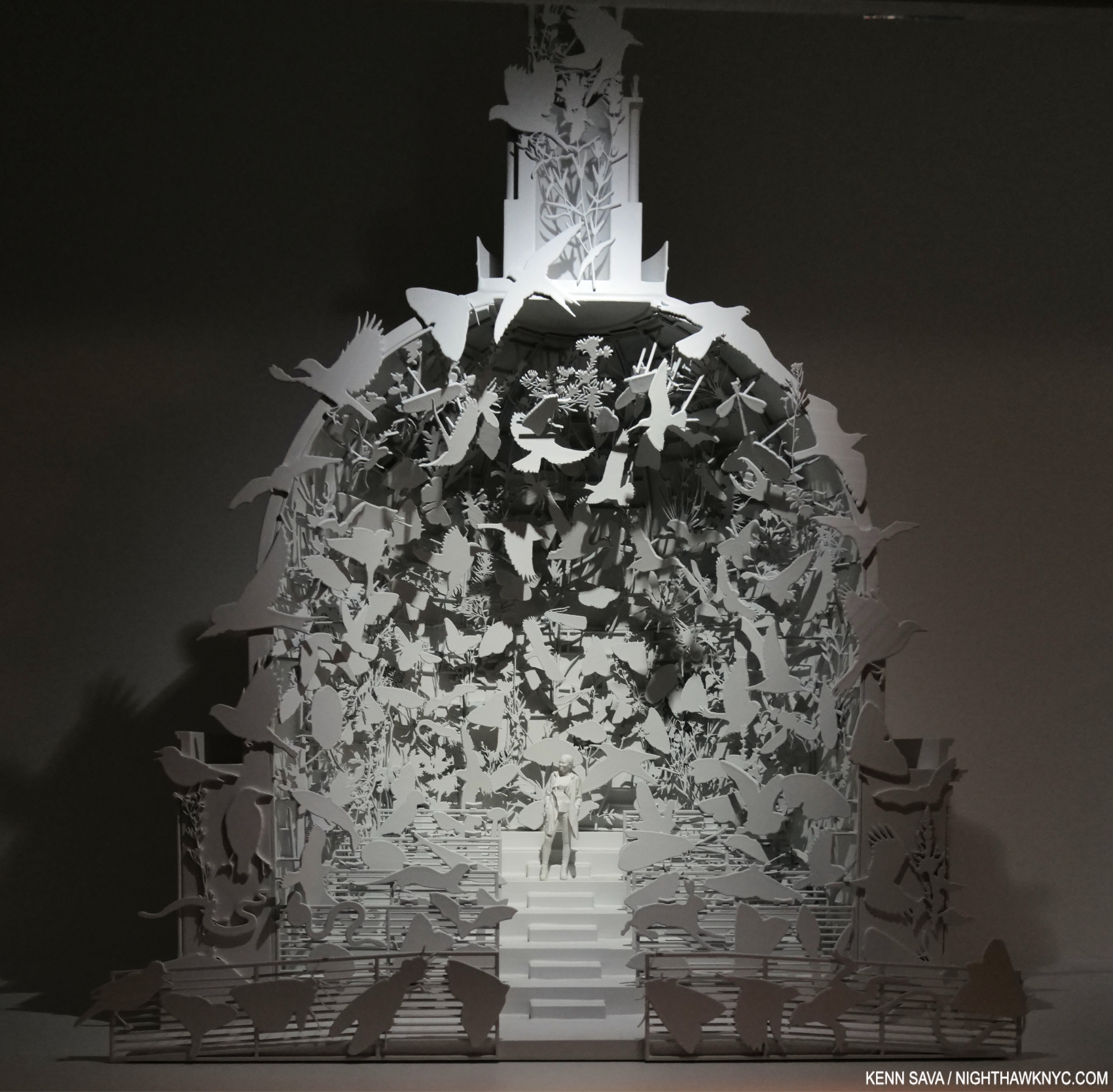
Model: Come Home Again, 2022, Acrylic and printed resin. “For Come Home Again, I constructed a one-third-scale replica of the dome of London’s St. Paul’s Cathedral on the lawn outside Tate Modern, facing the cathedral across the river. I filled dome with observational drawings of 243 of the 15,000 non-human species that call London home; the Londoners most at risk of extinction. ”All of the 243 animals depicted were based on Es Devlin Drawings.
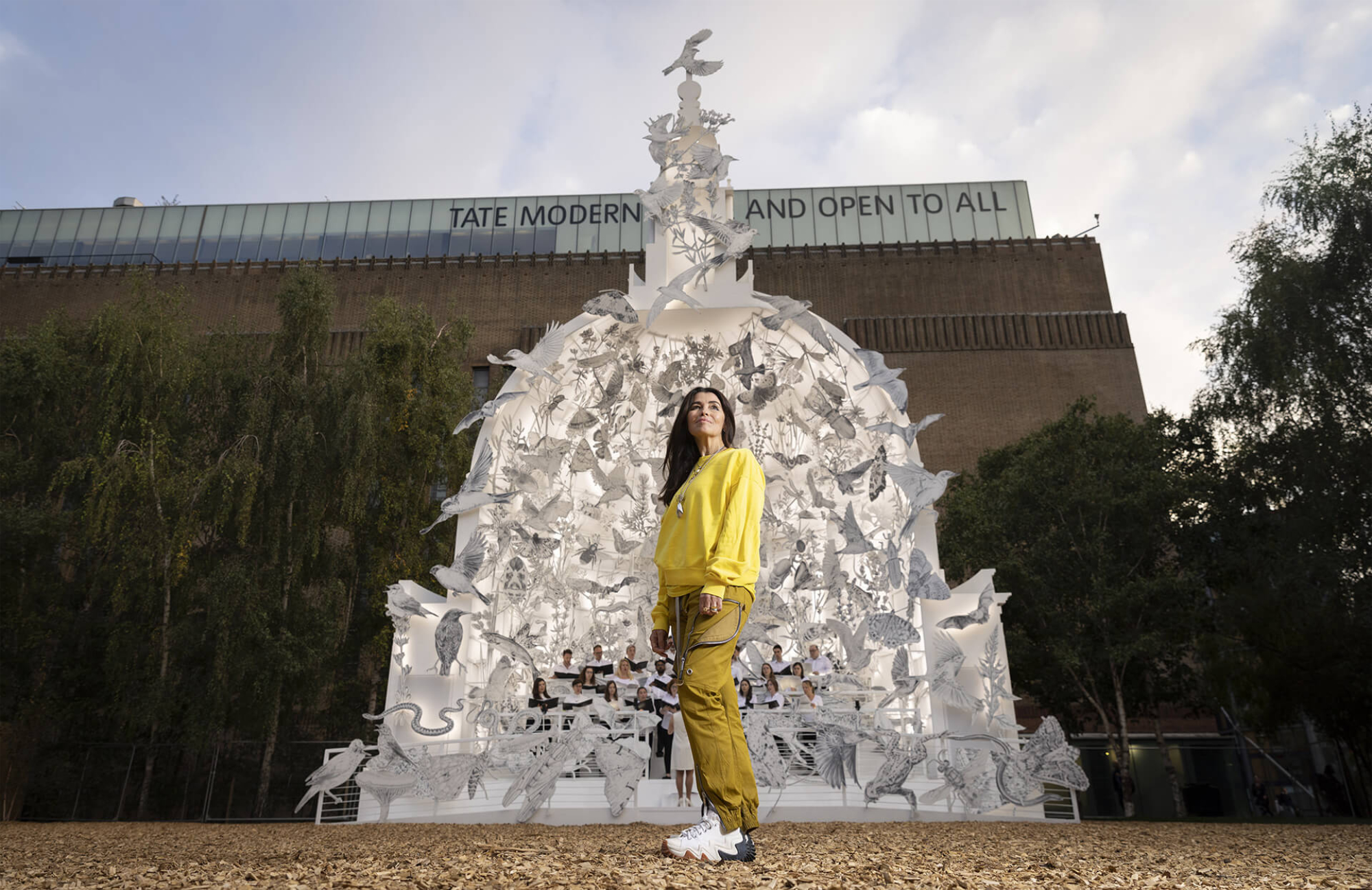
Es Devlin in front of the real Come Home Again, Tate Modern, London, 2022 *- Photo by Matt Alexander
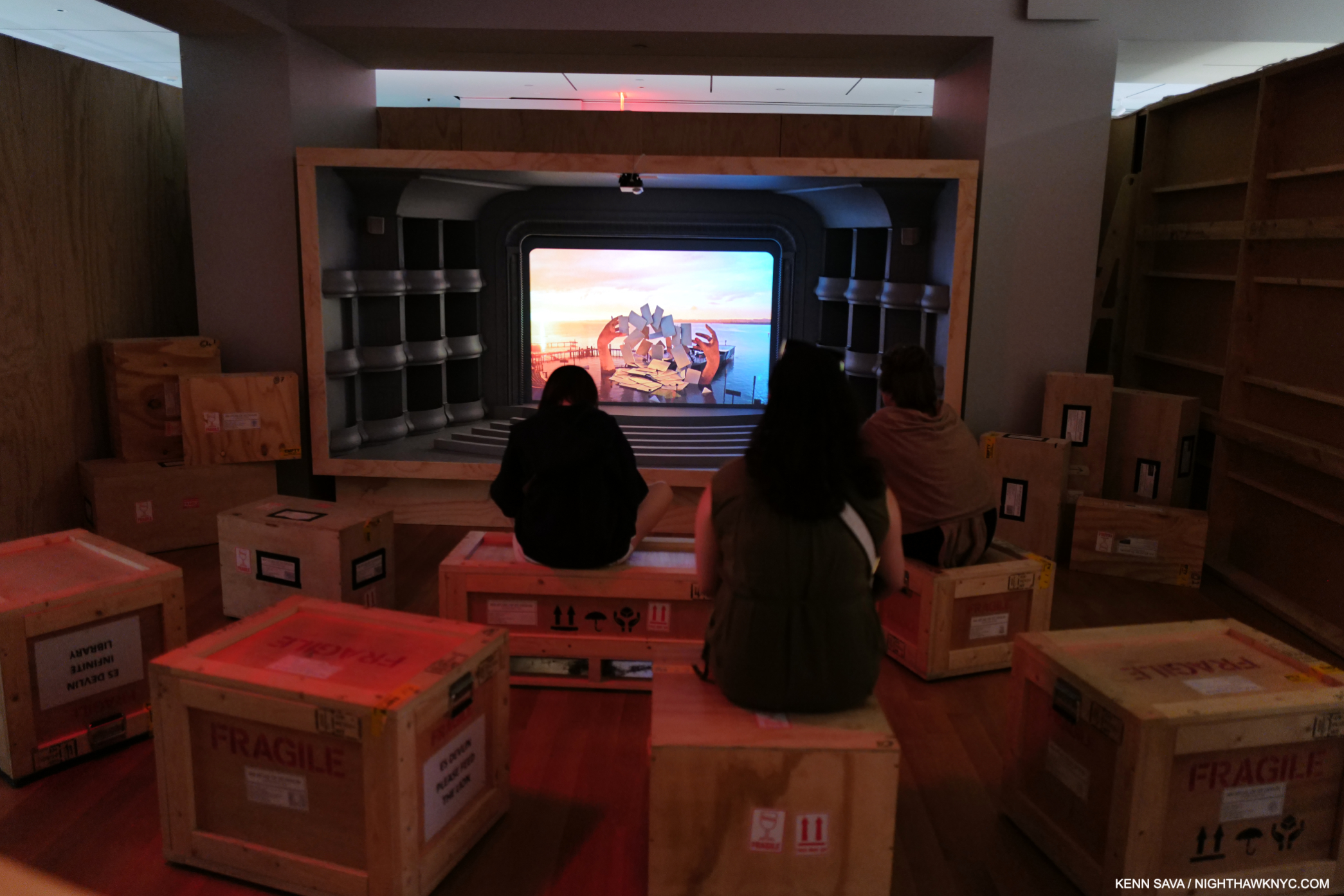
The shipping crates for the Art, teased earlier, filled a gallery where a video screen was mounted in a stage set, providing seats for the visitors, with more all around me as I took this, and, cutting down on the need for space to store them! Something I’ve never seen before, it’s a touch that shows the depth of the imagination and attention to detail that went into An Atlas at the Cooper Hewitt.
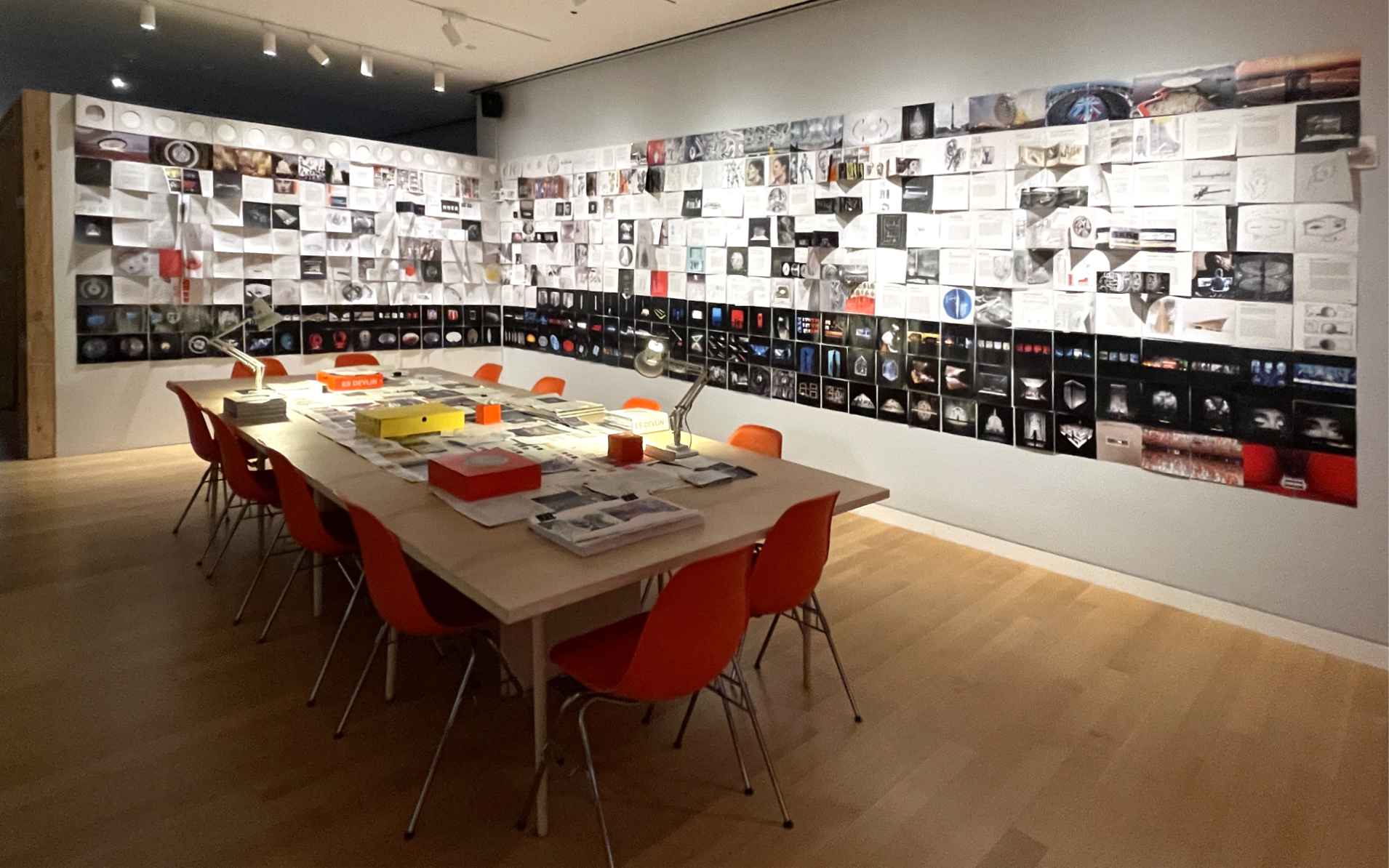
As if all the thought, planning and work that went into mounting An Atlas wasn’t enough, there is the incredibly innovative 900-page(!) book that accompanies it! So far, it’s the only Art book I’ve named a NoteWorthy Art Book for 2024, and that was before I saw the show. Here, in the show’s final gallery, another recreation of her studio, visitors get a look at the making of it, including the original book dummy (off-camera, in a vitrine to my left). This time, visitors were free to handle the items on the table, which were reproductions of the original work materials…right?
An Atlas, the show, reveals, that as her fame and notoriety grows, so too are the opportunities for the Artist to step out and present her own work, without an overriding “boss,” as she has in major works like Come Home Again, and Your Voices, both 2022, and, of course, in An Atlas of Es Devlin, the book & show. Her own work shows the Artist bringing “big questions” to the forefront- including species near extinction (in Come Home Again, and in her piece Nevada Ark for U2’s The Sphere shows in 2023),
That Es Devlin’s work, and practice, is deeply rooted in traditional Art-making techniques, like Drawing and Sculpture, is a continual touchstone in both the show and the book. She uses them to produce work that lives on, and continually pushes, the cutting-edge of Stage Design and Production. I find this both fascinating and inspiring. On one hand, her example shows what is still possible by just putting pen or pencil to paper; that a master’s or doctorate degree are not prerequisites for achieving a very successful career, or greatness, in one’s chosen field in the Arts. On the other, it also reaffirms over and over again the power of one person’s creative vision. In her chosen field, her work strikes me as being downright unprecedented. In the larger world of Art, Es Devlin’s vision is at once as personal and as expansive as almost anyone else’s working today.
*- Soundtrack for this piece is “Who’s Gonna Ride Your Wild Horses,” by U2 from Achtung Baby, 1991.
My look at the 900-page An Atlas of Es Devlin, the NighthawkNYC.com NoteWorthy Art Book of 2024, published to accompany the show, is here.
NighthawkNYC.com has been entirely self-funded & ad-free for 9 years, during which 330 full-length pieces have been published! If you’ve found it worthwhile, PLEASE donate by PayPal below to allow me to continue. Thank you, Kenn.
You can also support it by buying Art, Art & Photography books, and Music from my collection! Art & Books may be found here. Music here and here.
Written & photographed by Kenn Sava for nighthawknyc.com unless otherwise credited. To send comments, thoughts, feedback or propositions click here. Click the white box on the upper right for the archives or to search them. Subscribe to be notified of new Posts below. Your information will be used for no other purpose.
For “short takes,” my ongoing “Visual Diary” series, and outtakes from my pieces, be sure to follow @nighthawk_nyc on Instagram!
Thank you, SV.

